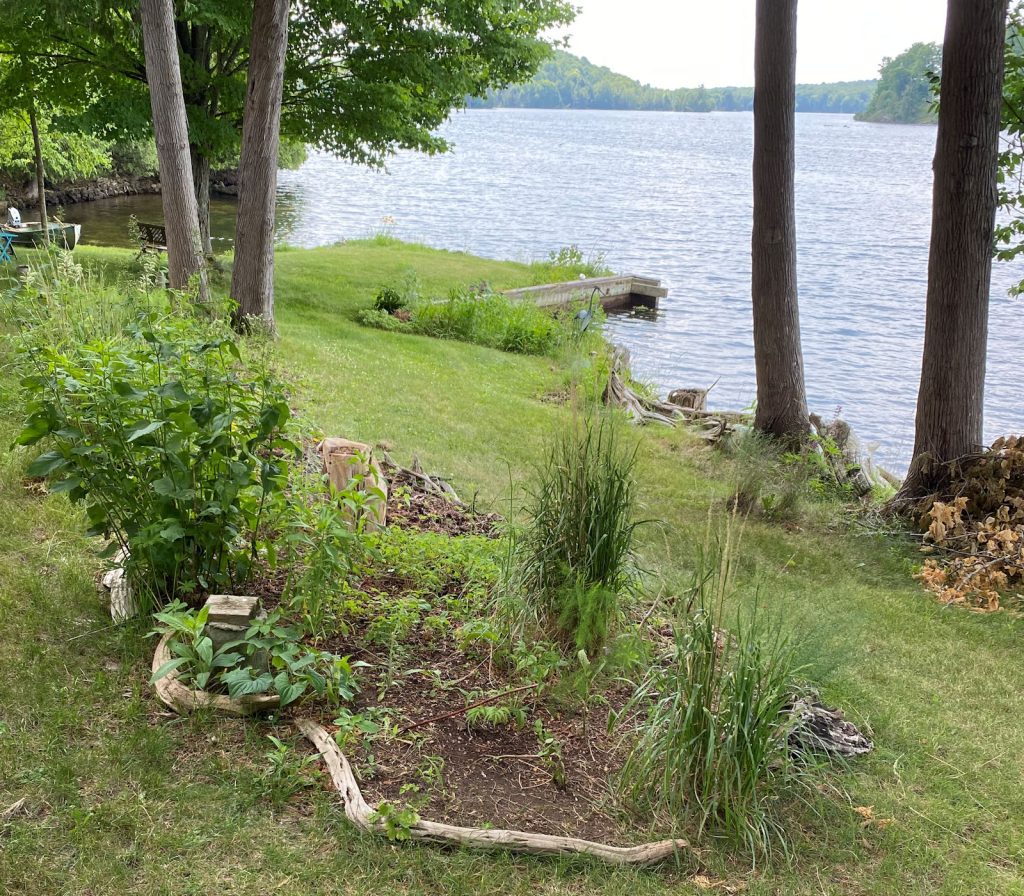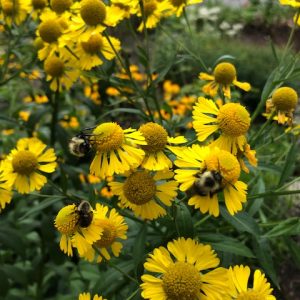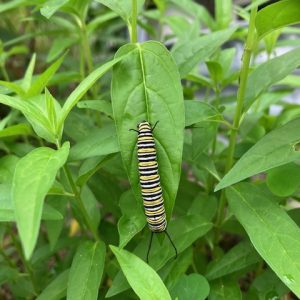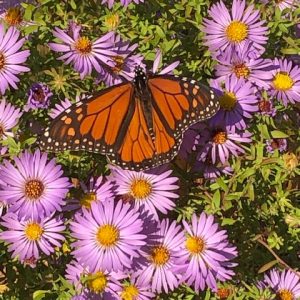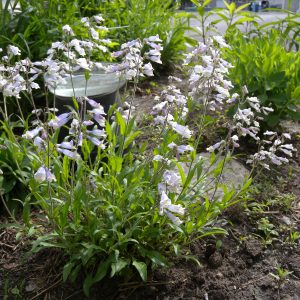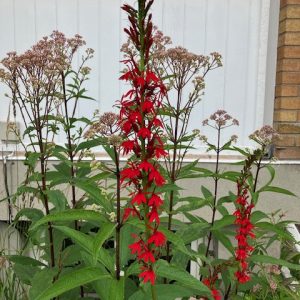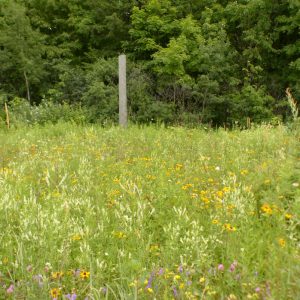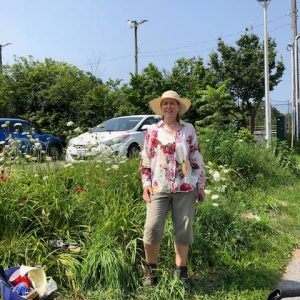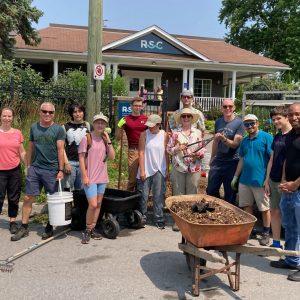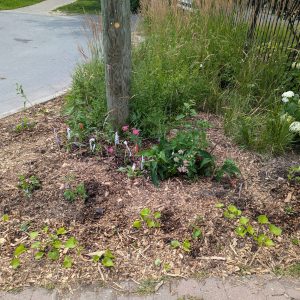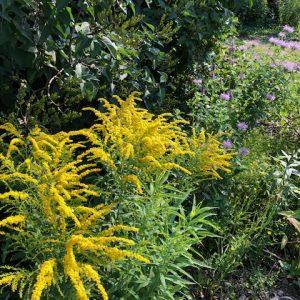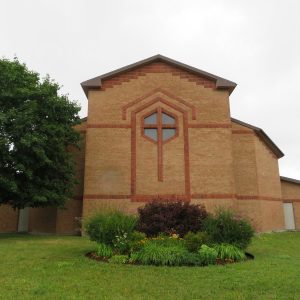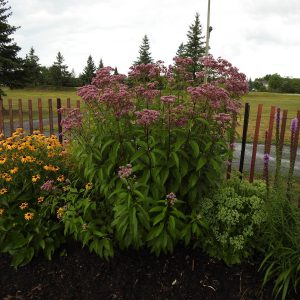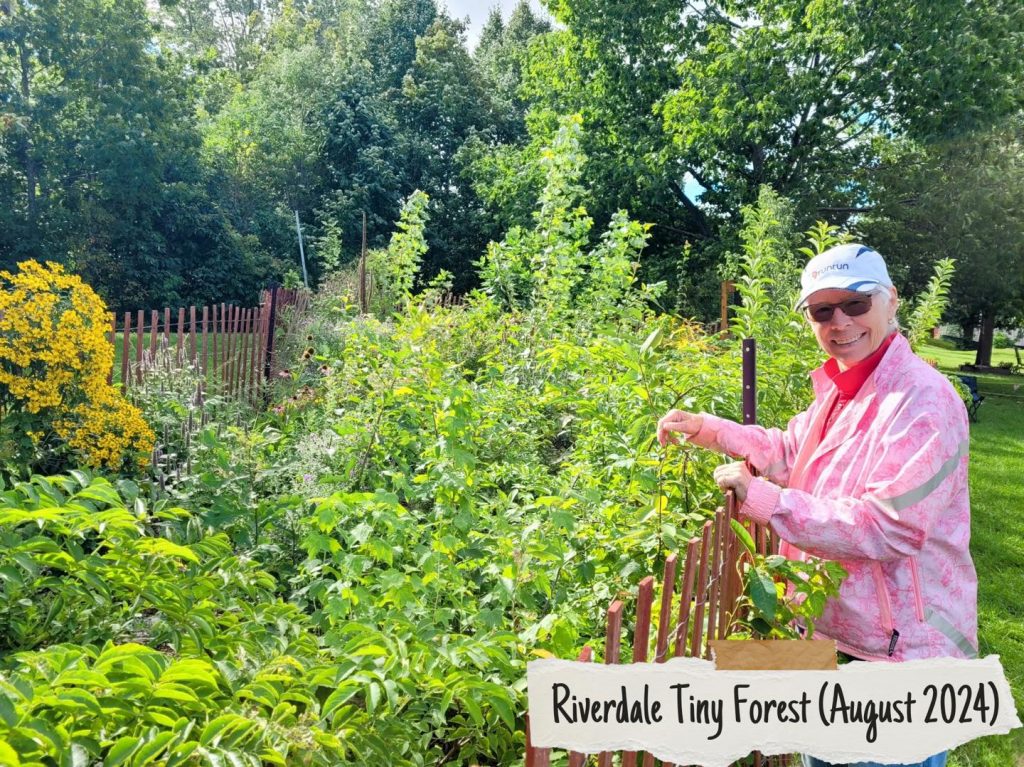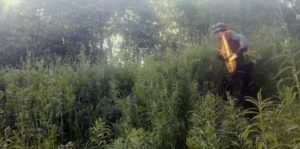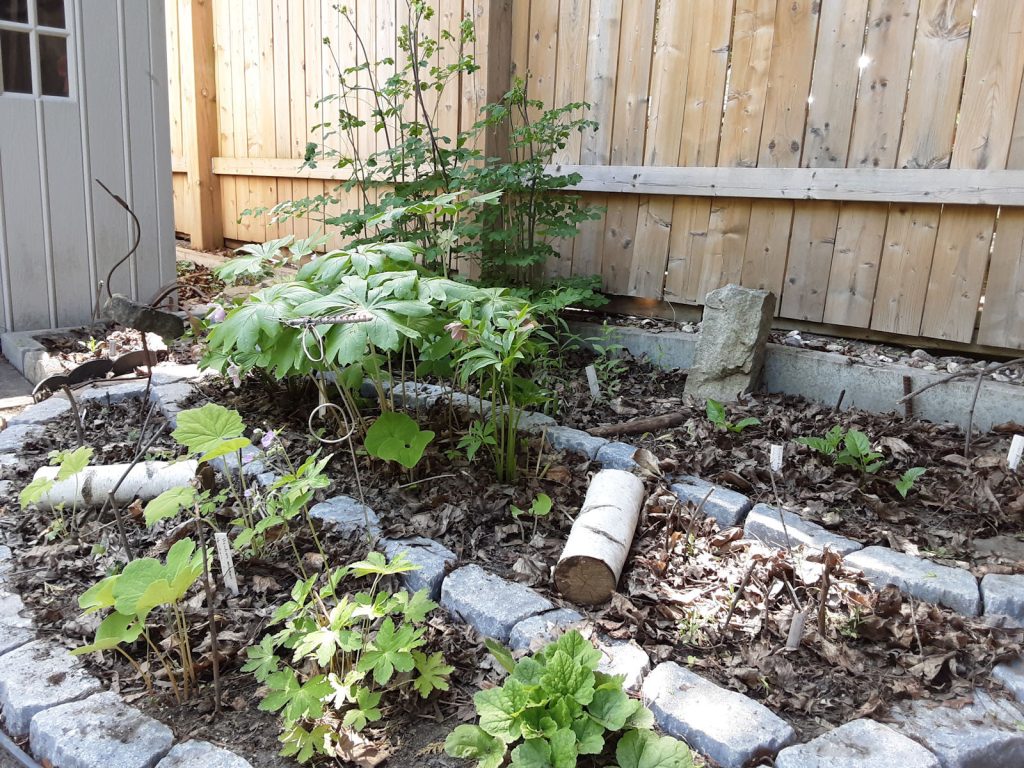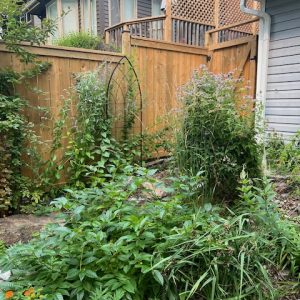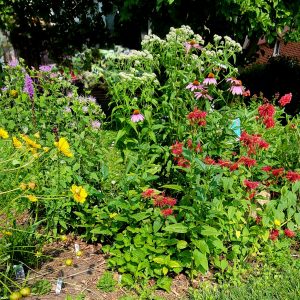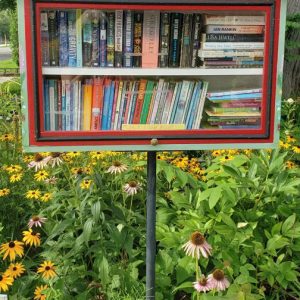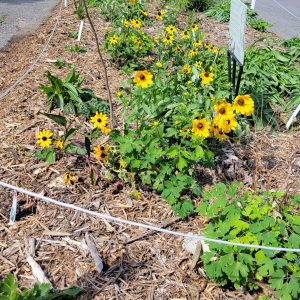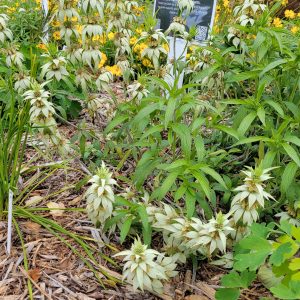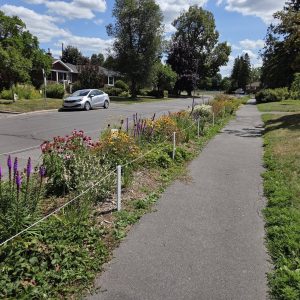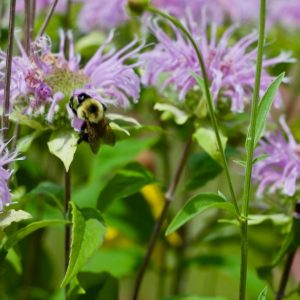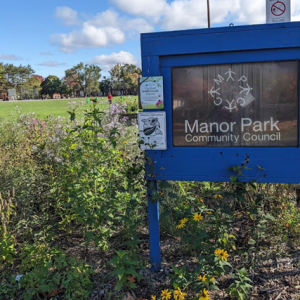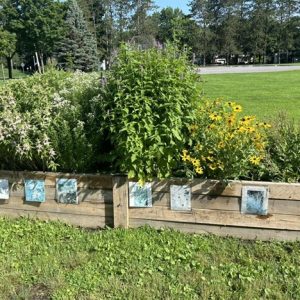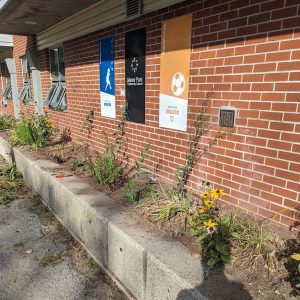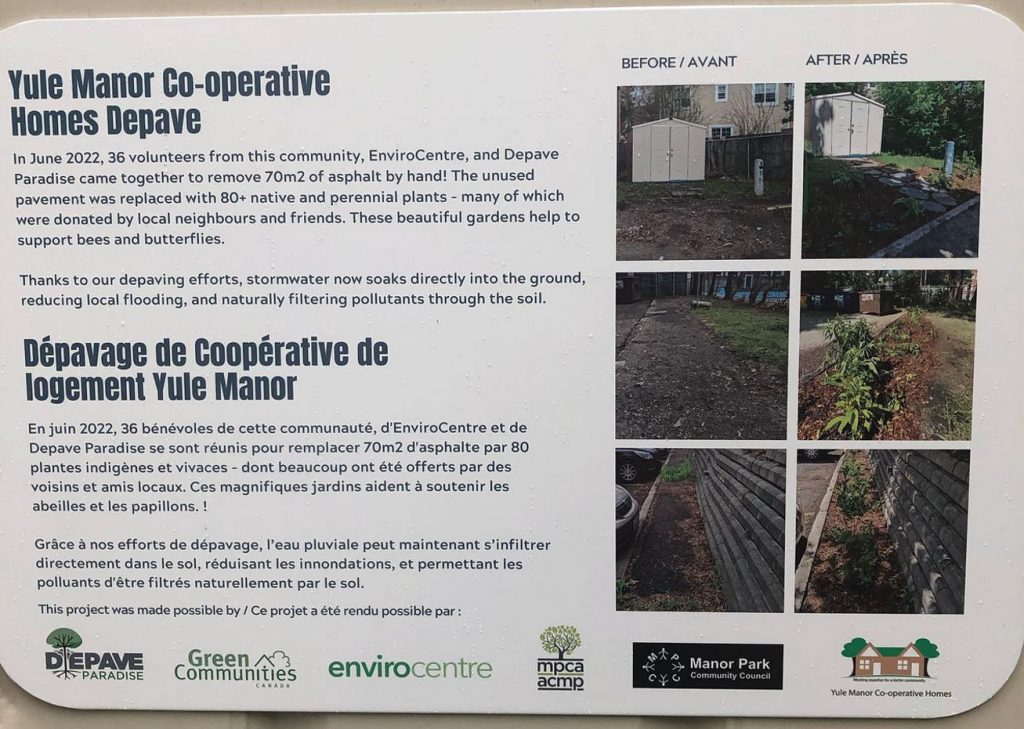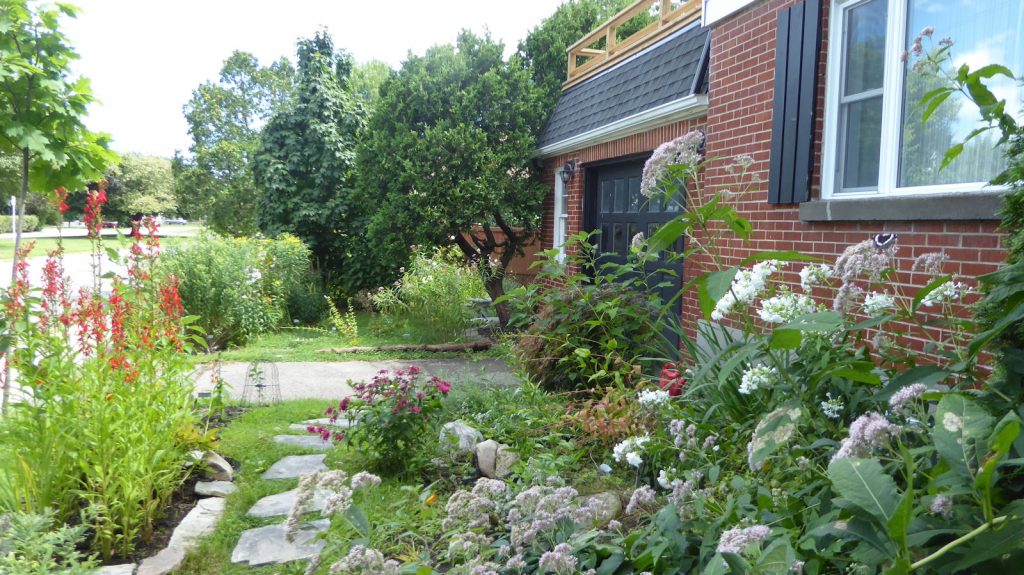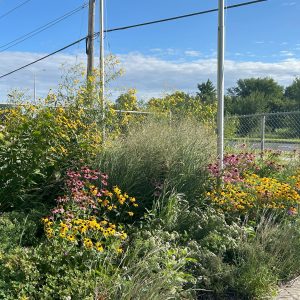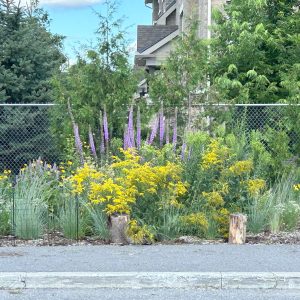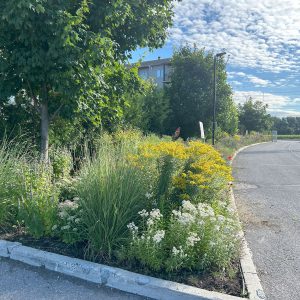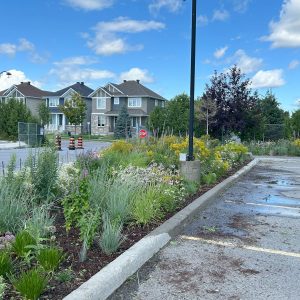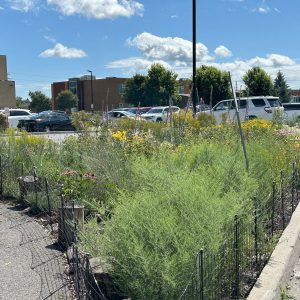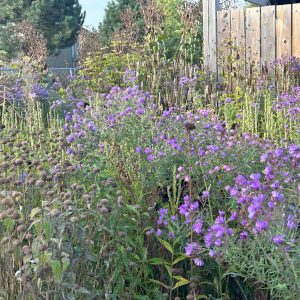One of the main goals of the Wild Pollinator Partners network is
to increase the area, connectivity, and quality of biodiverse pollinator habitats and ecosystems in Ottawa and the Ottawa region by promoting and integrating native plants
In other words, plant more native plants everywhere! We try to keep track of progress toward this goal by mapping pollinator habitat in parks, rights-of-way, schools, churches, roadsides, and private gardens.
To include your garden, community, school, or other pollinator garden or habitat on our map, please send us its title, location, size, photograph, and a brief description – info@wildpollinators-pollinisateurssauvages.ca
Thanks for helping to save our pollinators and natural ecosystems!
Abbotsford gardens
Behind Abbotsford Seniors' Centre, 950 Bank Street Show on Map
Volunteer Carol MacLeod takes care of about 25 square metres of pollinator beds on the Monk Street side of this seniors’ centre in the Glebe.
Alcove Garden – Kitchissippi United Church
Island Park Drive, Ottawa Show on Map
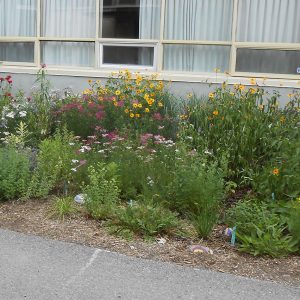 The Alcove Garden consists of three beds on the south side of Kitchissippi United Church (KUC) near the entrance to the Montessori school on Island Park Drive near the Queensway. The total area is 110 square metres.
The Alcove Garden consists of three beds on the south side of Kitchissippi United Church (KUC) near the entrance to the Montessori school on Island Park Drive near the Queensway. The total area is 110 square metres.
This pollinator garden was created in 2014 as part of a depave project, by KUC members in conjunction with Ecology Ottawa and Intact Insurance. It was maintained by church volunteers until 2020, when management was offered to the Master Gardeners of Ottawa Carleton (MGOC). MGOC volunteers now take care of the garden and communicate with the church about their efforts. They are shifting toward more native plants and wildlife-friendly practices.
See blog post: History of the Alcove Garden
Allbirch pollinator garden
PrivateAllbirch Road, Constance Bay Show on Map

A “food forest” combining fruit and nut trees and shrubs with the perennials, like goldenrods, that pollinators love
Hank and Vera Jones have tuned the front garden of their half-acre lot (2000 square m) into a pollinator garden. In addition to perennials, it contains many fruit and nut trees. Their backyard is CWF-certified wildlife habitat. They also grow vegetables and salad greens in portable tables and enjoy foraging produce from the trees.
Hank recalls: “Launched in 2008, the APG started by “rewilding” the site – letting what was already there show its face; over a hundred plants did so. Ottawa By-Law did not approve. We spent the first year arguing that the city was already asking for such places, but their rules contradicted. We were finally vindicated. However, this contradiction has emerged repeatedly for others in the region seeking the same emancipation – victoriously in every case as I can recall.
“Advice: allow meadow patches to emerge and expand simply by progressively mowing less and less area until only pathways remain. This way, you will not attract the lightning, I expect.”
Almonte pollinator garden
155 High Street, Almonte, Ontario Show on Map
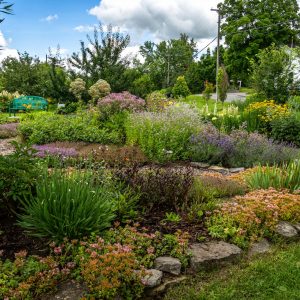 Established in 1992 by the Almonte & District Horticultural Society, this garden has evolved over the years from the original nine inner flower beds to include a large berm alongside High St. and two smaller berms as well as one raised wooden bed, for a total of about 150 square metres.
Established in 1992 by the Almonte & District Horticultural Society, this garden has evolved over the years from the original nine inner flower beds to include a large berm alongside High St. and two smaller berms as well as one raised wooden bed, for a total of about 150 square metres.
In recent years, many new pollinator plants have been introduced in the gardens such as Asclepias, Verbena bonariensis, various coloured coneflowers, many alliums and aster varieties, and mulleins.
At the 100th anniversary (1921-2021) celebration of the A&DHS, a metal work of art was placed in the center of our garden entitled Anthophilia – the love of flowers – by both human visitors and our pollinating insects!
AVCA – Grasshopper Hill Park
Grasshopper Hill Park, Kilborn Avenue Show on Map
 In Alta Vista, a group of volunteers led by Michelle St-Germain is battling Dog-strangling Vine in 5 areas and replacing it with native wildflowers, often grown by those volunteers. This patch is one of three in Grasshopper Hill Park.
In Alta Vista, a group of volunteers led by Michelle St-Germain is battling Dog-strangling Vine in 5 areas and replacing it with native wildflowers, often grown by those volunteers. This patch is one of three in Grasshopper Hill Park.
Please see Dog-strangling Vine management project for more information.
AVCA – Pleasant Park at Lynda Lane
Pleasant Park at Lynda Lane Show on Map
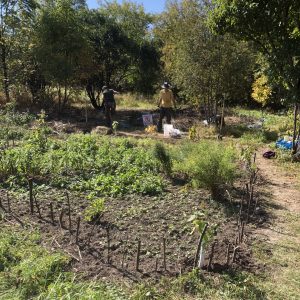 In Alta Vista, a group of volunteers led by Michelle St-Germain is battling Dog-strangling Vine (DSV) in 5 areas and replacing it with native wildflowers, often grown by those volunteers. This pollinator patch is on Pleasant Park Road at the corner of Lynda Lane. The photo at the left was taken in 2023, after volunteers had removed hundreds of DSV plants.
In Alta Vista, a group of volunteers led by Michelle St-Germain is battling Dog-strangling Vine (DSV) in 5 areas and replacing it with native wildflowers, often grown by those volunteers. This pollinator patch is on Pleasant Park Road at the corner of Lynda Lane. The photo at the left was taken in 2023, after volunteers had removed hundreds of DSV plants.
Please see Dog-strangling Vine management project for more information.
AVCA – Wren’s Way at Wesmar
Wren's Way Park at Wesmar Show on Map
 In Alta Vista, a group of volunteers led by Michelle St-Germain is battling Dog-strangling Vine in 5 areas and replacing it with native wildflowers, often grown by those volunteers. This patch is in Wren’s Way Park at the end of Wesmar Drive.
In Alta Vista, a group of volunteers led by Michelle St-Germain is battling Dog-strangling Vine in 5 areas and replacing it with native wildflowers, often grown by those volunteers. This patch is in Wren’s Way Park at the end of Wesmar Drive.
Please see Dog-strangling Vine management project for more information.
AVCA – Wren’s Way on Amberdale
Wren's Way on Amberdale Show on Map
In Alta Vista, a group of volunteers led by Michelle St-Germain is battling Dog-strangling Vine in 5 areas and replacing it with native wildflowers, often grown by those volunteers. This patch is in Wren’s Way Park near Amberdale.
Please see Dog-strangling Vine management project for more information.
Bee Spot
Hampton Park, north entrance Show on Map
The Bee Spot opened in June 2023. Located in an Ottawa park, this 2-m2 demonstration garden includes about 50 plants, all native wildflower species. The garden shows others what they can grow in their own gardens, provides food and habitat for pollinating insects and birds, seeds for the future, and reduces unwanted plant species. All plants were grown from seed by Nepean High School ecology students, who also helped prepare the area and plant.
It also acts as a focal point for activities and events that highlight the need to protect and conserve all types and sizes of ecosystems.
See blog post about this project for details.
Contact person: Sharon Boddy: CarlingtonHampton@gmail.com
Bob’s Lake – rewilding, north of Westport
PrivateCrozier Road, Westport Show on Map
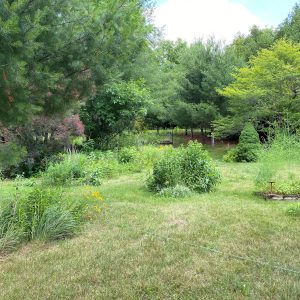 Bruce McEwen is replacing numerous invasive species and lawn with native wildflowers on his lakeside property. He writes: “We have 1.5 acres (0.6 ha) on Bob’s Lake. The land was cow pasture when my dad bought it in 1979. He turned it into a manicured lawn with some traditional gardens. The property includes shady lakefront, lawn, hills, woods, areas with shallow soil over Canadian Shield rock, and a sunny dry plateau – quite varying conditions to experiment with growing natives.
Bruce McEwen is replacing numerous invasive species and lawn with native wildflowers on his lakeside property. He writes: “We have 1.5 acres (0.6 ha) on Bob’s Lake. The land was cow pasture when my dad bought it in 1979. He turned it into a manicured lawn with some traditional gardens. The property includes shady lakefront, lawn, hills, woods, areas with shallow soil over Canadian Shield rock, and a sunny dry plateau – quite varying conditions to experiment with growing natives.
Over the last 3 years, I have winter sowed seeds of about 100 native species from the Ottawa Wildflower Seed Library, with varied success. Each spring, young native plants displace some more lawn. The property is large enough to accommodate additional trees. Five pawpaws winter-sowed in 2023 are planted on a hillside near two new hop trees and a struggling young tulip tree. There are also two young Kentucky coffee trees as well as numerous young oak and pine trees.
Half my gardening time is spent fighting invasives: dog strangling vine, dames rocket, ox eye daisy, lily of the valley, periwinkle, ditch lily, Chinese lantern, creeping bell flower and others. When an invasive is removed native seeds or young native plants go into the space.
Brenda’s pollinator garden
PrivateScott Street, Ottawa Show on Map
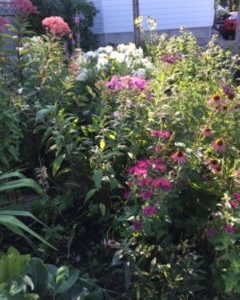 As Brenda MacKenzie describes it, “My crazy garden is an ordinary urban lot. I have Joe-Pye Weed, three kinds of milkweed, wild irises, native Cardinal Flower, echinacea, Beebalm, and old-fashioned tall zinnias, all of which attract bees and butterflies. The bees in the yard are pretty clearly some variety of carpenter bee. There are other species too, but there are hundreds of carpenter bees. Our neighbour had to cut down a large dying maple and had a lot of the wood stacked in his yard. This may be providing the habitat for the wild bees.
As Brenda MacKenzie describes it, “My crazy garden is an ordinary urban lot. I have Joe-Pye Weed, three kinds of milkweed, wild irises, native Cardinal Flower, echinacea, Beebalm, and old-fashioned tall zinnias, all of which attract bees and butterflies. The bees in the yard are pretty clearly some variety of carpenter bee. There are other species too, but there are hundreds of carpenter bees. Our neighbour had to cut down a large dying maple and had a lot of the wood stacked in his yard. This may be providing the habitat for the wild bees.
“We have included more native plants in recent years, installed a disappearing stream, have been using no pesticides, and have composted avidly for 30 years. The results were not instant, but we have all manner of visitors — bees, songbirds, dragonflies, and butterflies, including red and white admirals, black swallowtails, and monarchs. All of these come and go depending on what is blooming.”
The area of this garden is about 80 square metres.
Brewer Pond
Brewer Pond, Old Ottawa South, Ottawa Show on Map
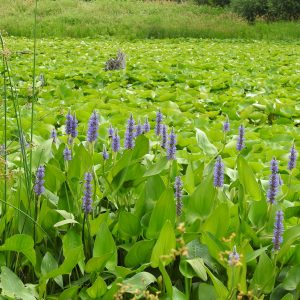 In 2015, the Rideau Valley Conservation Authority had an opportunity to open up Brewer Pond and reconnect it with the Rideau River. Once a series of islands, the pond was created artificially to serve as a swimming beach in the early 1960s. Only a few years later, it was closed permanently to swimming because of water pollution. Almost 30 years later, the local community entered into an agreement with the city to naturalize the area.
In 2015, the Rideau Valley Conservation Authority had an opportunity to open up Brewer Pond and reconnect it with the Rideau River. Once a series of islands, the pond was created artificially to serve as a swimming beach in the early 1960s. Only a few years later, it was closed permanently to swimming because of water pollution. Almost 30 years later, the local community entered into an agreement with the city to naturalize the area.
The move to reconnect the pond with the river allowed fish, beavers, and turtles to move freely between them. At the same time, extensive planting of native species – wildflowers, shrubs, and trees – occurred all around the pond.
The photo at the right shows the pond in August – filled with white water lilies (a favourite of resident beavers) and blue Pickerel Weed in the foreground. The pond is surrounded by Swamp Milkweed, Monkeyflower, Blue Flag, Jerusalem Artichoke, Meadowsweet, Joe-Pye Weed, and other native wildflowers, Big Bluestem and Indian Grass, as well as sedges, rushes, and numerous non-native species, such as Stinging Nettle. Shrubs include Red Osier Dogwood, Buttonbush, and Highbush Cranberry. Silver Maples, and several species of willows were also planted in 2015.
No planting is required here, but the Enviro Crew of Old Ottawa South attempts to control invasive species, such as Wild Parsnip, Common Burdock, Dog-strangling Vine, Garlic Mustard, Phragmites, and European Buckthorn, and protect the area from too much “traffic.” The area is approximately 60,000 square metres.
Contact: envirocrewoos@gmail.com
Brewer Pond butterfly meadow
100 Brewer Way, Ottawa Show on Map
 At Brewer Pond, the butterfly meadow (about 3000 square metres) began as an experiment to find plants that can compete with Dog-strangling Vine. We knew goldenrods and Purple-flowering Raspberry could do that, but we’ve added asters, hyssop, yarrow, and bergamot in the sunny field that used to be a parking lot. In the shade, we’re trying White Snakeroot, Zigzag Goldenrod, Giant Yellow Hyssop, and Ostrich Fern.
At Brewer Pond, the butterfly meadow (about 3000 square metres) began as an experiment to find plants that can compete with Dog-strangling Vine. We knew goldenrods and Purple-flowering Raspberry could do that, but we’ve added asters, hyssop, yarrow, and bergamot in the sunny field that used to be a parking lot. In the shade, we’re trying White Snakeroot, Zigzag Goldenrod, Giant Yellow Hyssop, and Ostrich Fern.
Contact: envirocrewoos@gmail.com
Bridge-to-Bridge project
East side of Bronson Avenue in Old Ottawa South Show on Map
 Residents of Old Ottawa South are turning a strip of mowed grass into an urban meadow and forest filled with a diversity of trees, shrubs, grasses, and flowers that support pollinators and other beneficial insects. The area is approximately 9000 square metres.
Residents of Old Ottawa South are turning a strip of mowed grass into an urban meadow and forest filled with a diversity of trees, shrubs, grasses, and flowers that support pollinators and other beneficial insects. The area is approximately 9000 square metres.
See blog post: Bridge-to-bridge community reforestation project
Brighton mini-meadows
Brighton Beach Park Show on Map
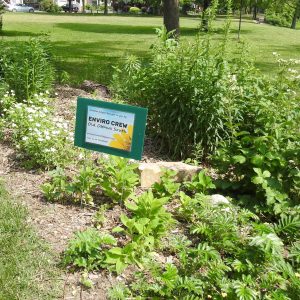 Inspired by the micro-forest idea and an aim to increase biodiversity in our parks, the Enviro Crew of Old Ottawa South designed and planted two mini-meadows at Brighton Beach Park, each about 20 square metres.
Inspired by the micro-forest idea and an aim to increase biodiversity in our parks, the Enviro Crew of Old Ottawa South designed and planted two mini-meadows at Brighton Beach Park, each about 20 square metres.
They chose a variety of common local wildflowers (bought from and donated by the Fletcher Wildlife Garden) and shrubs (bought at Ferguson Forest Tree Nursery), planting them in clusters. They added a generous number of rocks, logs, and stumps to create microclimates for the plants, then topped it all with mulch to hold in water.
Contact: envirocrewoos@gmail.com
See blog post: Brighton Beach Park mini-meadows
Cally’s garden
PrivateBirchland Crescent, Stittsville Show on Map
Cally has planted two 37-square-metre areas with native wildflowers in her backyard in Stittsville and plans to add more. She says:
“We moved to our house in June 2012. The backyard of our newly built house was mostly “fill” with a layer of topsoil and sod. We started with a small garden bed created by removing the sod and composting it. The first plot was a herb plot or kitchen garden, but in 2020, I became interested in native plants because I heard about their important role in supporting pollinators and the local ecosystem. While searching for more information about native plants, I heard about Seedy Saturdays and the Ottawa Wildflower Seed Library (OWSL). I was very happy to know that many people are concerned about the biodiversity crisis and are active in supporting pollinators.
“We got started by planting some swamp milkweed and cardinal flowers, which we purchased at Seedy Saturday in 2018. We attended our first OWSL seed exchange and tried winter-sowing, which I heard about through the Facebook group of the OWSL. To my surprise most of the seeds germinated and I planted them in the soil, and here we are three years later. From seeds made available for free through the OWSL we have winter-sown more species in each of the past few years, and now have many new seedlings in various stages of growth.
“Earlier this summer, we removed sod for another native plant bed that is intended for native plants that like full sun and dry soil. I save seeds from most of the native plants in our garden and pack them for the OWSL’s annual seed exchanges in the fall. Our interest hasn’t waned, and we are planning to remove more sod this summer for more native plant and pollinator garden beds.”
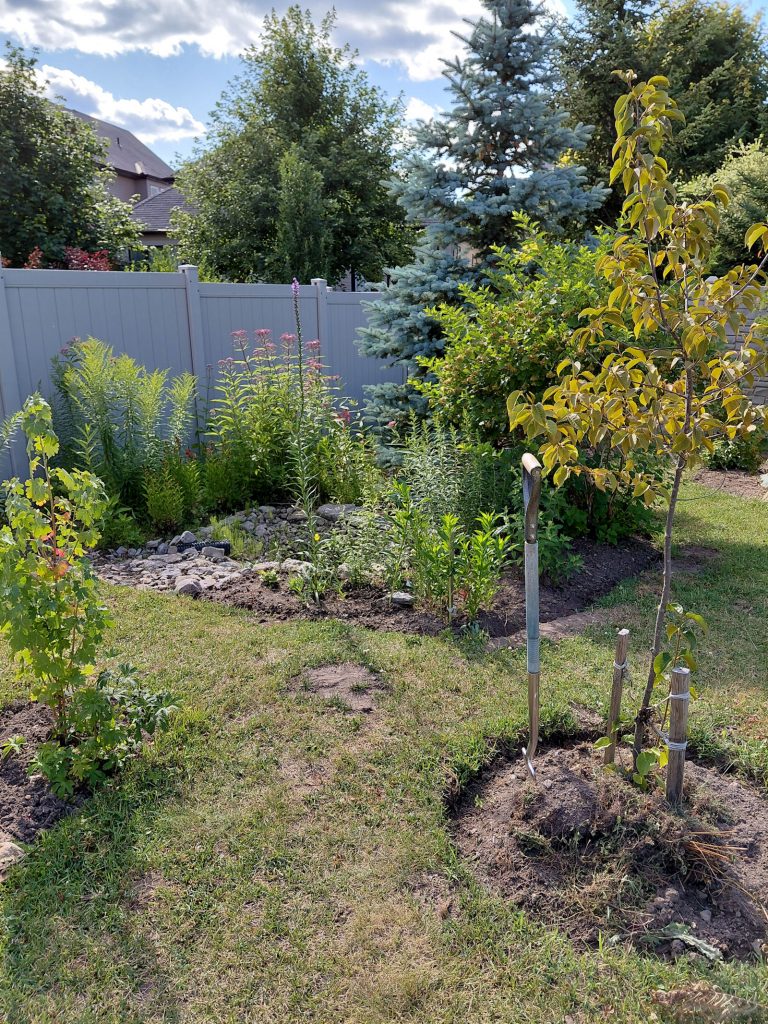 |
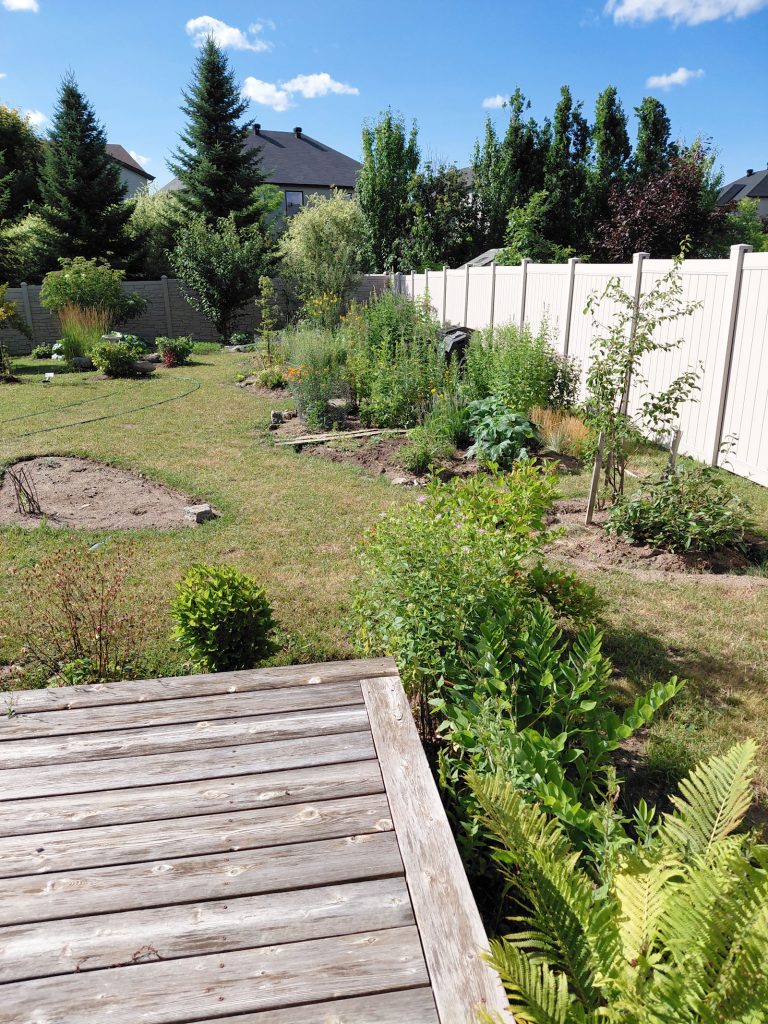 |
Canadian Martyrs Catholic Church
Main Street, Ottawa East Show on Map
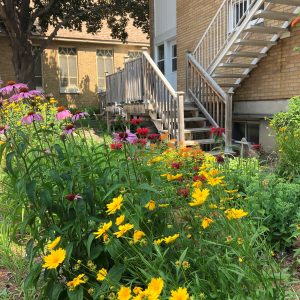 The 1.5 square metre pollinator garden at Canadian Martyrs began in 2017 with a Canadian Wildlife Federation “4 pack”: Butterfly Milkweed, Swamp Milkweed, Gayfeather, and Coreopis. These plants were quickly joined by a few Prairie Smoke and Golden Alexander from the Fletcher Wildlife Garden plant sale.
The 1.5 square metre pollinator garden at Canadian Martyrs began in 2017 with a Canadian Wildlife Federation “4 pack”: Butterfly Milkweed, Swamp Milkweed, Gayfeather, and Coreopis. These plants were quickly joined by a few Prairie Smoke and Golden Alexander from the Fletcher Wildlife Garden plant sale.
In a subsequent season Faith and the Common Good donated Sneezeweed, Hairy Beardtongue, Grey-headed Coneflower, and Wild Bergamot and connected the parish with Wild Pollinator Partners. Since that time, parish gardeners have added Beebalm, Pearly Everlasting, Great Blue Lobelia, Black-eyed Susan, Eastern Columbine, and native asters to this site. Other beds already had Obedient Plant, Jack-in-the-Pulpit, and Bloodroot. More native perennials and several native shrubs have joined the ornamental beds. Joe-Pye Weed, Cardinal Flower, and Swamp Milkweed now thrive in a raingarden.
Since 2023, parishioners have benefited from a seed giveaway encouraging them to try growing native plants at home.
Canadian Wildlife Federation
350 Michael Cowpland Drive, Kanata Show on Map
 The CWF includes a pollinator bed among its many demonstration gardens, complete with a plant list. An interactive map on its web site allows you to click on each plant for photos and more information.
The CWF includes a pollinator bed among its many demonstration gardens, complete with a plant list. An interactive map on its web site allows you to click on each plant for photos and more information.
Blog post (2018): The trials, tribulations, and joys in running a demonstration garden
Blog post (2024): Visiting the CWF demonstration gardens
Canadian Wildlife Federation Monarch recovery project 1
Christie Lake Road, Lanark County Show on Map
 The Canadian Wildlife Federation (CWF), in partnership with the National Capital Commission, Hydro One, and Lanark County, is testing whether the creation of native meadows along roadsides and rights‐of‐way can successfully control Wild Parsnip, while restoring Monarch butterfly habitat and reducing management costs.
The Canadian Wildlife Federation (CWF), in partnership with the National Capital Commission, Hydro One, and Lanark County, is testing whether the creation of native meadows along roadsides and rights‐of‐way can successfully control Wild Parsnip, while restoring Monarch butterfly habitat and reducing management costs.
Right‐of‐way corridors that are restored for Monarch butterflies will be used as a nursery for caterpillars, fuel for the long journey of the adults, and rest stops along the way. They will also be beautiful sites to behold for Monarch lovers across the province.
Canadian Wildlife Federation Monarch recovery project 2
Fallbrook Road, Lanark County Show on Map
Second CWF test site
Canadian Wildlife Federation Monarch recovery project 3
Riverside Drive Show on Map
Third CWF test site.
See blog post: Finding pollinators in the McCarthy hydro cut
Canadian Wildlife Federation Monarch recovery project 4
Greens Creek Show on Map
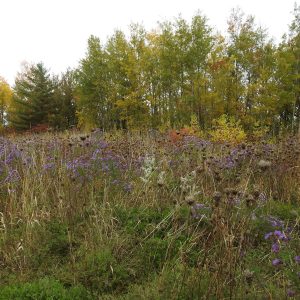 This CWF test site is between the Sir George Étienne Parkway and the Ottawa River near Green’s Creek. A patch the size of a football field was plowed several times to break up sod, then seeded with a mix of wildflowers and grasses: Virginia Wildrye (Elymus virginicus), Big Bluestem (Andropogon gerardi), Little Bluestem (Schizachyrium scoparium), and Indiangrass (Sorghastrum nutans); Joe-Pye Weed (Eupatorium maculatum), Sneezeweed (Helenium autumnale), Evening-primrose (Oenothera biennis), Brown-eyed Susan (Rudbeckia hirta), Virginia Mountain Mint (Pycnanthemum virginianum), and many others; and millet to help support initial growth.
This CWF test site is between the Sir George Étienne Parkway and the Ottawa River near Green’s Creek. A patch the size of a football field was plowed several times to break up sod, then seeded with a mix of wildflowers and grasses: Virginia Wildrye (Elymus virginicus), Big Bluestem (Andropogon gerardi), Little Bluestem (Schizachyrium scoparium), and Indiangrass (Sorghastrum nutans); Joe-Pye Weed (Eupatorium maculatum), Sneezeweed (Helenium autumnale), Evening-primrose (Oenothera biennis), Brown-eyed Susan (Rudbeckia hirta), Virginia Mountain Mint (Pycnanthemum virginianum), and many others; and millet to help support initial growth.
See blog post Creating pollinator habitat from scratch
Champlain Park pollinator garden
Sir John A. Macdonald Parkway at Champlain Park Show on Map
 Champlain Park’s pollinator garden is part of a larger plan to rehabilitate a stretch of woodland along the Sir John A. Macdonald Parkway. The Environment Committee of the Champlain Park Community Association is spearheading this work. They’ve mobilized volunteers to help bring a variety of native plants into the public woodlands and residential area.
Champlain Park’s pollinator garden is part of a larger plan to rehabilitate a stretch of woodland along the Sir John A. Macdonald Parkway. The Environment Committee of the Champlain Park Community Association is spearheading this work. They’ve mobilized volunteers to help bring a variety of native plants into the public woodlands and residential area.
As described in the 2020 annual report, “Specific activities related to this project include planting native trees, shrubs and spring ephemeral and summer flowering plants in small, compact areas cleared of non-native invasive vegetation. Funding was provided by local residents and the City of Ottawa Community Environmental Projects Grant Program.”
See blog post: Champlain Woods – bringing native biodiversity into our neighbourhood
Churchill Alternative School
Churchill Alternative School Show on Map
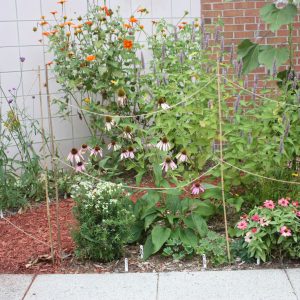 In April 2019, the school council asked Berit Erickson to help creat a butterfly garden at her son’s elementary school, Churchill Alternative School. Each spring, it was enthusiastically planted, but struggled on its own after the student gardeners left for the summer. A low-maintenance, mostly-native perennial garden would be a perfect replacement.
In April 2019, the school council asked Berit Erickson to help creat a butterfly garden at her son’s elementary school, Churchill Alternative School. Each spring, it was enthusiastically planted, but struggled on its own after the student gardeners left for the summer. A low-maintenance, mostly-native perennial garden would be a perfect replacement.
According to Berit, “My first task was to come up with a list of suitable butterfly plants for this sunny, dry location. We needed two kinds: nectar-rich flowers to feed adult butterflies and host plants to feed their caterpillars.” See her blog post:
Down to the nitty gritty: creating the Churchill Alternative School butterfly garden
City Hall pollinator garden
111 Lisgar Street, Ottawa Show on Map

The city’s new pollinator garden is on the Lisgar Street side of City Hall. Forestry contributed “stepping stones” made of slices of ash wood and the garden also features an insect hotel. Photo by Amy MacPherson, June 2019.
This small raised garden on the Lisgar Street side of City Hall was created in 2019 just in time for Pollinator Appreciation Day on June 7.
The following plants were ordered from Ferguson Forest Tree Nursery: Butterfly Weed (12), Blazing Star (14), and Lance-leaved Coreopsis (16). The Fletcher Wildlife Garden contributed New England Aster, Pearly Everlasting, Wild Bergamot, Blue Vervain, Prairie Smoke, Rough Goldenrod, and Common Milkweed. A rose was already growing in the bed along with various grasses. A barrel in the centre contains horticultural varieties, such as petunias, geraniums, and salvia.
A small insect hotel was mounted on the wall at the back of the garden. By 19 July 2019, it was clearly being used.
For more, see blog posts:
Pollinator Appreciation Day in Ottawa
City Hall bee hotel is back in business!
City Hall pollinator garden – year 1 in review
Clyde Bee & Butterfly Patch
Clyde Avenue at Castle Hill Show on Map
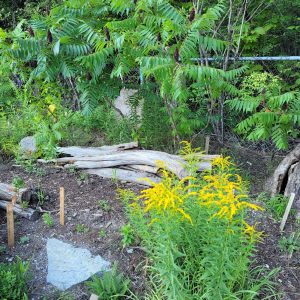 Clyde Bee & Butterfly Patch is an effort to make use of a rather inhospitable (for plants) but public space along the shoulder of the road and near an entrance to the multi-use path in Carlington Woods where lots of people pass to take their dogs for walks or just bike or walk themselves.
Clyde Bee & Butterfly Patch is an effort to make use of a rather inhospitable (for plants) but public space along the shoulder of the road and near an entrance to the multi-use path in Carlington Woods where lots of people pass to take their dogs for walks or just bike or walk themselves.
Goldenrod, asters, and sumac were all growing there already making it quite lovely in the fall but it was not offering any food for pollinators in spring or summer. We started a lot of plants by seed and have gratefully received a few donations. The plants were selected to be suitable for a sunny location with poor, dry soil. With watering to get them through the hot dry June and July, we have managed to keep most of them going and a few are starting to flower.
The site is landscaped to include habitat structures in the form of logs, tree stumps, an artificial mud puddle and a water dish. There is signage to help explain what the purpose of it is and to identify it.
Anyone is welcome to visit it on their own or contact me, Nora Lee, via cccpollinator@gmail.com
See also, Nora’s photo album Clyde-Carlington Pollinator garden and web site
Corner Pollinator Garden
PrivateFraser at Sherbourne Show on Map
 Last spring, Berit Erickson turned a front yard, on a busy urban corner, into a pollinator garden. Because so many people stop by while she is working in the garden, she created a brochure full of great tips and information about what she is doing. Berit kindly shared a copy with us.
Last spring, Berit Erickson turned a front yard, on a busy urban corner, into a pollinator garden. Because so many people stop by while she is working in the garden, she created a brochure full of great tips and information about what she is doing. Berit kindly shared a copy with us.
Web site: cornerpollinatorgarden.net
Brochure: Create your own pollinator garden
Blog post: Plant it and they will come: my corner pollinator garden
Dalhousie South Park
Dalhousie South Park Show on Map
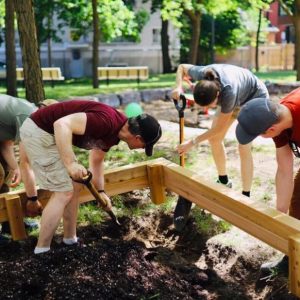 Overcoming shortage of space, a shady location, and miles of “red tape,” the Glebe Annex Community Association established a pollinator garden in Dalhousie South Park on Bell Street. Plants include Zigzag Goldenrod, White Snakeroot, Yellow Giant Hyssop, Honewort, Anise Hyssop, Golden Alexanders, and Virgin’s Bower Clematis.
Overcoming shortage of space, a shady location, and miles of “red tape,” the Glebe Annex Community Association established a pollinator garden in Dalhousie South Park on Bell Street. Plants include Zigzag Goldenrod, White Snakeroot, Yellow Giant Hyssop, Honewort, Anise Hyssop, Golden Alexanders, and Virgin’s Bower Clematis.
In July 2021, GACA president Sue Stefko says, “So far, it seems that insects of the chewing kind are enjoying the garden more than insects of the buzzing kind, but we’re starting to see some of the flowers peek out, and we’re hopeful that the plants can grow and get stronger before they are totally devoured.”
Blog post: Pollinator garden at Dalhousie Park – it takes a village
Donald Street boulevard gardens
Donald Street, Overbrook Show on Map
These eight gardens are located on the City of Ottawa Right of Way on both sides of West Donald Street from the entrance to the Rideau Sports Club to North River Road.
Native plants are being introduced to enhance the monoculture of hybrid lilies and restore public lands that have been neglected. This restoration and maintenance process started in 2022 and is being done through an agreement with the City of Ottawa’s Roads Department and the Overbrook Community Association. In 2024, most beds were restored by using cardboard and woodchips to suppress Dog-strangling Vine, Wild Mustard, Wild Parsnip, and Manitoba Maples. In the fall, small seedlings were planted as part of a pollinator project with Ecology Ottawa.
In 2025, students from the Ottawa Technical Secondary School will be winter sowing seeds from the Ottawa Wildflower Seed Library. Seedlings and donated plants will allow us to complete our final garden plot in the spring of 2025.
Contact: garden@overbrook.ca
École élémentaire publique Trille des Bois
Genest Street Show on Map
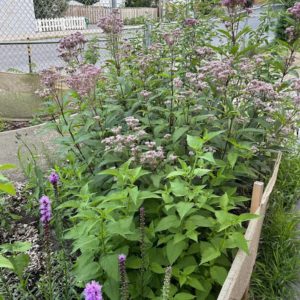 In spring 2023, a pollinator garden and a rain garden totalling 92 square metres were installed at the school with support from a City of Ottawa community environmental grant. Students and parent volunteers took the lead with the support of the school staff and administration.
In spring 2023, a pollinator garden and a rain garden totalling 92 square metres were installed at the school with support from a City of Ottawa community environmental grant. Students and parent volunteers took the lead with the support of the school staff and administration.
You can read more about the rain garden on the EnviroCentre web site: Un jardin de pluie à l’école Trille des Bois. Its more than 90 shrubs (8 species) and over 250 native wildflowers (25 species) attract numerous pollinators, other insects, and birds.
The raingarden was a good choice for a problem area in the schoolyard where rain runoff was causing erosion and leaving mud on the sidewalk. Following instructions from Rain Ready Ottawa’s webinars, the school created a garden that absorbs the runoff.
Read more about this and other school gardens on Ecology Ottawa’s web site: How to create a wildlife garden at your child’s school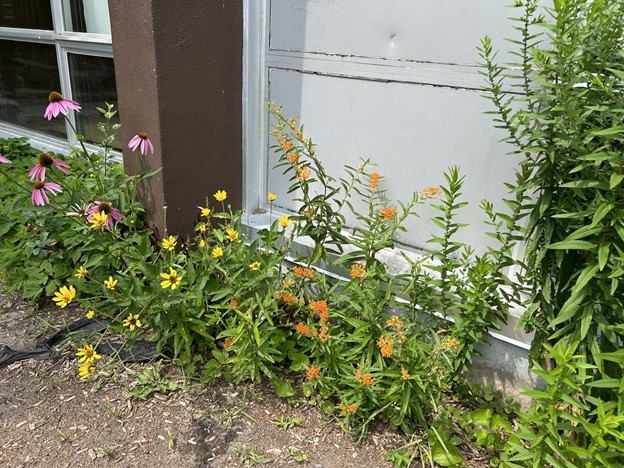
Faith communities (Faith and the Common Good partners)
Faith & the Common Good (FCG) is a national environmental NGO that works with faith and spiritual communities in their efforts to become more “ecological.” The local Ottawa FCG chapter has been promoting sustainable and ecological gardening for the past few years and was thrilled to partner up with Wild Pollinator Partners to support pollinators and add more native plants to the following gardens.
FCG – All Saints Anglican Church
Richmond Road, Westboro, Ottawa Show on Map
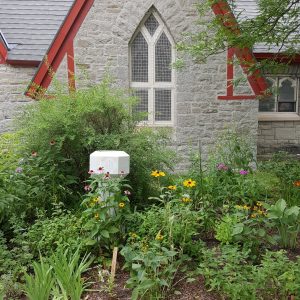 All Saints Anglican Church in Westboro designed a shady courtyard garden that has become a community amenity along Richmond Road where many people enjoy sitting on the benches and relaxing by the garden beds. Here, Pearly Everlastings have been added along with Spotted Beebalm and other native flowers.
All Saints Anglican Church in Westboro designed a shady courtyard garden that has become a community amenity along Richmond Road where many people enjoy sitting on the benches and relaxing by the garden beds. Here, Pearly Everlastings have been added along with Spotted Beebalm and other native flowers.
FCG – Holy Cross Catholic Church
Walkley Road, Ottawa Show on Map
FCG – Knox Presbyterian Church
Elgin at Lisgar Show on Map
Added to our downtown pollinator survey in 2019. A courtyard off Elgin Street is a green oasis where shrubs, perennials, and Winston the Groundhog live.
FCG – Orleans United Church
Orléans Boulevard, Orleans, Ottawa Show on Map
Orleans United Church, on Orleans Blvd close to Bilberry Creek, is situated on an extensive lot with a tree-lined entrance and various garden beds on all sides of the church. Their new biodiversity prayer garden will include Grey-headed Coneflowers, asters, Yarrow, and Golden Alexander, and they have also added some native shade plants to their current beds.
FCG – Sheng Shen Catholic Church
Michael Street, Ottawa Show on Map
Sheng Shen Catholic Church, on Michael Street near St. Laurent mall, wanted to add some pollinator plants to support their community garden and prayer space. Their additions include Wild Bergamot, Yarrow, and Grass-leaved Goldenrod.
FCG – St. Barnabas Anglican/Catholic Church
James Street, Centretown, Ottawa Show on Map
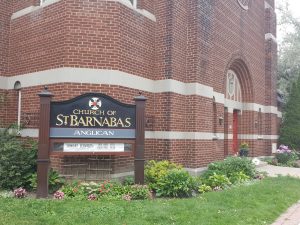 St. Barnabas Church on James Street is a downtown property with some beautiful ornamental garden beds along the sidewalk. It provides lovely colour along a busy city street, and they have now added asters, Black-eyed Susans, Cup-plants, and other natives.
St. Barnabas Church on James Street is a downtown property with some beautiful ornamental garden beds along the sidewalk. It provides lovely colour along a busy city street, and they have now added asters, Black-eyed Susans, Cup-plants, and other natives.
FCG – St. Basil’s Catholic Church
Rex Avenue, Ottawa Show on Map
St. Basil’s parishioners have turned a median in their parking lot into a flower oasis – although not all native plants – and are revitalizing a second spot by the church entrance.
FCG – St. Columba Anglican Church
Sandridge Road, Ottawa Show on Map
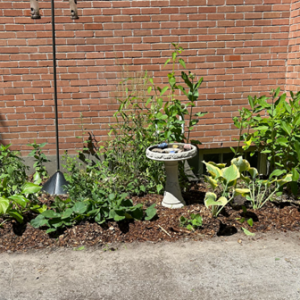 St. Columba Anglican Church, on Sandridge Road in Manor Park, is close to the Aviation Parkway and has a large property shaded in the front by maple trees. Heart-leaved Asters and native Columbines have been placed in the shady garden beds.
St. Columba Anglican Church, on Sandridge Road in Manor Park, is close to the Aviation Parkway and has a large property shaded in the front by maple trees. Heart-leaved Asters and native Columbines have been placed in the shady garden beds.
The garden (about 5 square metres), which is located at the side entrance of the church, was installed in collaboration with Faith and the Common Good many years ago. In summer 2024, it was refreshed by Manor Park Community Association Environment Committee volunteers and is now part of the Manor Park Butterflyway Project. The volunteers are also working with the church and other youth groups (including the 63rd Ottawa Scouts and the Girl Guides group, which meet regularly on the grounds) to remove invasive species, including goutweed and buckthorn, from the church property.
FCG – St. Luke’s Anglican Church
Somerset Street West, Ottawa Show on Map
FCG – St. Martin’s Anglican Church
Prince Charles Road, Ottawa Show on Map
FCG – St. Matthew’s Anglican Church
First Avenue, Ottawa Show on Map
First Avenue Public School
First Avenue Public School Show on Map
Started in 2019 in planters, but also an “empty” space between the playground and street.
Contact: Catherine Hall (teacher)
Fletcher Wildlife Garden
Prince of Wales Drive just south of the Dominion Arboretum Show on Map
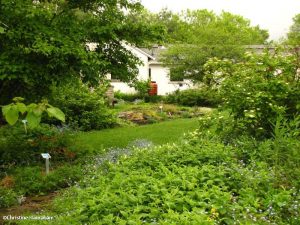 The Fletcher Wildlife Garden is a 6.5-ha natural area featuring several habitats that particularly attract pollinators.
The Fletcher Wildlife Garden is a 6.5-ha natural area featuring several habitats that particularly attract pollinators.
- Demonstration pollinator gardens in a box (at northeast corner of the Old Field habitat)
- Butterfly Meadow
- Backyard Garden (photo below)
Contact person: Sandy Garland fletcher@ofnc.ca
Flutter and Buzz Pollinator Patch
Stonecrest Park, Barrhaven Show on Map
Flutter and Buzz Pollinator Patch is in a city park next to a playground and Adrienne Clarkson Elementary School. It was started and is maintained by residents in the surrounding neighbourhood, especially Clare and her husband. It provides a learning site for the adjacent school to promote understanding, conservation and appreciation of nature.
In 2019, the garden was doing so well, Clare had Swamp Milkweeds to give away. She traded with the Fletcher Wildlife Garden for some earlier-blooming wildflowers – Prairie Smoke and Tall Cinquefoil – to put in the new bed in the centre of the circular garden.
Contact person: Clare
Forest Garden Friends
PrivatePleasant Park near Alta Vista Show on Map
 From Sarah M.L. Walker: Our garden is a food forest, with domesticated edibles intermingled with (sometimes edible to humans) native species. Our property is large and the pollinator plants are distributed throughout.
From Sarah M.L. Walker: Our garden is a food forest, with domesticated edibles intermingled with (sometimes edible to humans) native species. Our property is large and the pollinator plants are distributed throughout.
Each year I try to add new native, pollinator and wildlife-friendly plants. I’m also planning to grow extra native pollinator plants to share with others in my neighbourhood and help them get started on their own pollinator gardens.
I am also part of the Suzuki Foundation’s Butterflyway project, and I’ll be offering tours of the property.
See blog post for more information and photos
Forêt Capitale Forest – demonstration plots
FCF headquarters, Pépin Ct Show on Map
Forêt Capitale Forest is becoming a leader in the Miyawaki Method Tiny Forest movement in the National Capital Region. Since May 2022, FCF has planted 13 tiny forests, five at its base of operations in Blackburn Hamlet.
The Miyawaki Method is a forest planting method created by Japanese botanist Akira Miyawaki that aims to help restore native ecosystems by accelerating the natural vegetation succession process. The method is characterized by amending the soil with natural and organic materials to replicate the soil composition of a mature forest, planting a wide range of native or naturalized species, and planting multiple canopy layers of mature forest (i.e., overstory, understory, forest floor).
Tiny Forests can be employed as an efficient and effective way to increase access and exposure to green spaces, especially in smaller urban spaces.
Guide to planting tiny forests
| Demonstration plot 1 Date planted: May-June 2022 Total no. of plants: 441 (49 species)
Forest size: 130 square metres |
Demonstration plot 2 Date planted: June-August 2022 Total no. of plants: 214 (41 species)
Forest size: 130 square metres |
| Demonstration plot 3 Date planted: August-September 2022 Total no. of plants: 441 (34 species)
Forest size: 130 square metres |
Demonstration plot 4 Date planted: September 2022 Total no. of plants: 441 (36 species)
Forest size: 130 square metres |
Forêt Capitale Forest – Riverdale
PrivateRiverdale Avenue, Old Ottawa South Show on Map
Date planted: September 2023
Number of plants 612 (50 species)
- Trees = 214
- Shrubs = 195
- Forbes = 203
Forest size: 190 square metres
Project partners: Forêt Capitale Forest, Envirocentre, Ottawa Community Housing
Project funders: Josette Robertson and Joan Johnston Family Foundation, TD Green Spaces, Arbour Day Foundation
Frank Street pollinator beds
Frank Street, between Bank and O'Connor Show on Map
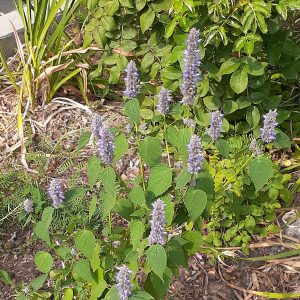 Carlos Murray has been adding pollinator plants to the raised garden beds along Frank Street between Bank and O’Connor in downtown Ottawa. This season he received donations from Nora Lee (Clyde Bee & Butterfly Patch) and the Fletcher Wildlife Garden.
Carlos Murray has been adding pollinator plants to the raised garden beds along Frank Street between Bank and O’Connor in downtown Ottawa. This season he received donations from Nora Lee (Clyde Bee & Butterfly Patch) and the Fletcher Wildlife Garden.
Carlos’s style is to include a variety of grasses – and a few common “weeds” – to create natural structure and support for the native wildflowers.
Next time you’re at Staples, take a minute to check out these evolving street beds.
Frederick Banting Alternative High School
Main Street, Stittsville Show on Map
Started in 2019.
Contact: Janet Perry (teacher)
Friends of Lanark County roadside wildflowers
County Road 12 (Macdonald's Corners Road) between Lanark and Elphin Show on Map
Friends of Lanark County are using the province’s Adopt-a-Road program to prevent roadside spraying of herbicides to control Wild Parsnip. Concerned over the health of native insects and anxious to preserve wildflowers along local roads, this group of “mostly seniors” is manually removing Wild Parsnip and planting native species both purchased and donated.
They are very disturbed by the increase in roadside spraying to deal with invasives and want to reach out and educate others about taking a more cautious and reasoned approach.
For more about this issue, please see
Friends of Petrie Island wildflower garden
Turtle Trail, Petrie Island Show on Map
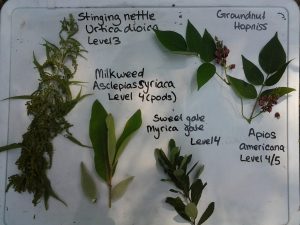 Throughout the seasons, flowering flora (plants and shrubs) are marked with informational signage that provides details on the species and its ecological, medicinal and edible properties. In May 2018, Petrie Island became a registered Monarch waystation.
Throughout the seasons, flowering flora (plants and shrubs) are marked with informational signage that provides details on the species and its ecological, medicinal and edible properties. In May 2018, Petrie Island became a registered Monarch waystation.
Glebe school garden
Glebe Collegiate Institute, Glebe Avenue, Ottawa Show on Map
This garden was created through a partnership between the Glebe Community Association Parks Committee, Glebe Collegiate’s environmental club, and the Ontario Nature Youth Council. It contains a variety of native perennials and a bee bath.
See news story about the project: Glebe’s abuzz (Glebe Report, August 16, 2018, page 36)
Hidden oasis
PrivateFourth Avenue Show on Map
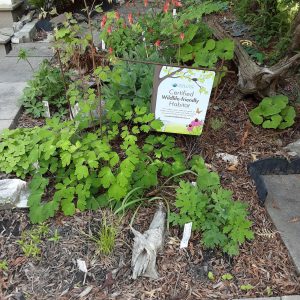 A long time gardener, Catherine John’s interest in native plants expanded after retirement while hiking in Gatineau Park with friends who would identify the spring ephemerals and other plants. Her large Manitoba Maple and other nearby trees, gave her the opportunity to recreate the woodland setting in her small Glebe backyard. Her first native plants were purchased at a neighbour’s annual plant sale. Jack-in-the-Pulpit, Wood Poppy, Mayapple, Great Blue Lobelia were placed among the hostas and astilbe, the only shade plants in the early 1990s. Over time, Bloodroot, and trilliums from a friend’s farm were added to the mix.
A long time gardener, Catherine John’s interest in native plants expanded after retirement while hiking in Gatineau Park with friends who would identify the spring ephemerals and other plants. Her large Manitoba Maple and other nearby trees, gave her the opportunity to recreate the woodland setting in her small Glebe backyard. Her first native plants were purchased at a neighbour’s annual plant sale. Jack-in-the-Pulpit, Wood Poppy, Mayapple, Great Blue Lobelia were placed among the hostas and astilbe, the only shade plants in the early 1990s. Over time, Bloodroot, and trilliums from a friend’s farm were added to the mix.
Late summer 2020, Catherine looked critically at some of those hostas. One was 4 feet in diameter! She figured she could get a lot of native plants into the space occupied by one hosta. Over the course of two summers, all the hostas were replaced by native plants.
In 2024, the focus turned to the tiny, 2-square-metre front garden on the north side of the house, beside the neighbour’s cedar. Astilbe and other plants were removed and replaced with Wood Poppy, Wild Geranium, Bloodroot, Heuchera, Hepatica, Columbine, and Wild Ginger.
There have been challenges. The large Manitoba Maple, creating dappled shade, had to come down. The woodland garden became part shade garden, Some plants didn’t like the sun and had to be relocated. Others, like the Jack-in-the-Pulpit and Bloodroot have adapted. One shady garden is under the neighbour’s Norway Maple. Many plants, native and non-native, did not survive the dense roots and dry soil, others were relocated. A portion of this garden would get runoff from the parking lot next door, washing soil into the flagstone path. The garden has been tiered, a channel created for runoff, and Inournature.ca recommended plants for dry shade. Some free plants – mislabeled and not appropriate for the space – had to be replaced. Others grown from seed have taken a while to become established or not returned the second year. Others thrived, put proved to be inappropriate for the location. It is a work-in-progess.
Holy Cross Pollinator Buffet
Holy Cross Catholic School Show on Map
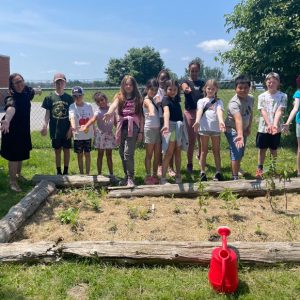 The Holy Cross Pollinator Buffet was created by the Holy Cross Green Team in collaboration with community members from OSEAN. It is a vibrant and biodiverse garden designed to attract and support pollinators.
The Holy Cross Pollinator Buffet was created by the Holy Cross Green Team in collaboration with community members from OSEAN. It is a vibrant and biodiverse garden designed to attract and support pollinators.
The garden is laid out in a thoughtful manner, using native plant species, including Wild Bergamot, Black-Eyed Susan, Pearly Everlasting, and many more! These plants were chosen specifically for their ability to provide nectar, pollen, and habitat for pollinators throughout the seasons. It covers a modest area at the front of our school grounds, easily accessible and visible to students and community visitors.
The garden serves as an outdoor classroom, where students learn about ecology, conservation, and the interdependence of plants and pollinators. It also encourages curiosity and respect for the natural world. In summary, our pollinator garden is not just a collection of plants; it is a dynamic ecosystem that supports biodiversity, educates our community and enriches the school environment with beauty and life.
Sonia Rankin, teacher
Lynne Patenaude and Heather Smith, OSEAN members
Jill’s pollinator garden
PrivateGlen Avenue, Ottawa Show on Map
Jill Jones’ pollinator garden is in its second year. Where there were once only common non-native plants and trees, she has planted over 30 native species in her backyard (110 m2) and side yard (7 m2). The garden is divided into sections:
- a full sun section (Wild Bergamot, Anise Hyssop, Pearly Everlasting, Butterflyweed, Culver’s Root, and Ohio Spiderwort); see photo
- a part sun/part shade area (Heart-leaved Asters, Bicknell Sedge, Porcupine Sedge, Black Cohosh, Wild Columbine, Hairy Beardtongue, Thimbleweed, and Sneezeweed)
- a woodland section (Ostrich Fern, Foamflower, Woodland Phlox, Maidenhair Fern, Sky Blue Aster, Eastern Redbud, Wooly Violet, Bottlebrush Grass and mosses)
- a shade section (Jerusalem Artichoke, Tall Meadowrue, Great Blue Lobelia and Philadelphia Fleabane)
- the side yard is under a retaining wall that drains into this yard so the garden has plants that like moisture (Joe-Pye Weed, Swamp Milkweed, Swamp Hibiscus, Dense Blazing Star, and Silverweed).
Just Food Farm
2391 Pepin Court, in the Greenbelt near Blackburn Hamlet Show on Map
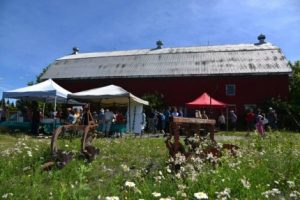 “Started in 2012, the Just Food Farm is where people and projects come together to model and inspire small-scale, viable agriculture businesses and initiatives in the Ottawa region.” Weedy fields and edges provide habitat for native pollinators and the farm created a pollinator hotel at a recent workshop.
“Started in 2012, the Just Food Farm is where people and projects come together to model and inspire small-scale, viable agriculture businesses and initiatives in the Ottawa region.” Weedy fields and edges provide habitat for native pollinators and the farm created a pollinator hotel at a recent workshop.
Kanata Muslim Association wildflower meadows
Kanata Muslim Association, 351 Sandhill Road Show on Map
The KMA wildflower meadows were established in 2023. We have only included plants that are native to Ontario and a few that are near natives. We have selected plants that are drought tolerant, salt tolerant, and need full sun.
When we first started, this area was full of construction debris, gravel, and a lot of invasives. The faith community came together to turn this little piece of land into beautiful meadows. We used seeds from the Ottawa Wildflower Seed Library and used a grant from Greening Sacred Spaces to buy seedlings from local vendors specializing in native plants. We were able to keep our costs very low and, within a year, the area had turned into full and lush meadows. We have also added rain barrels, bee hotels, and bird baths.
The meadows, which cover about 74 square metres, are located around the parking lot behind the main building on Sandhill Road.
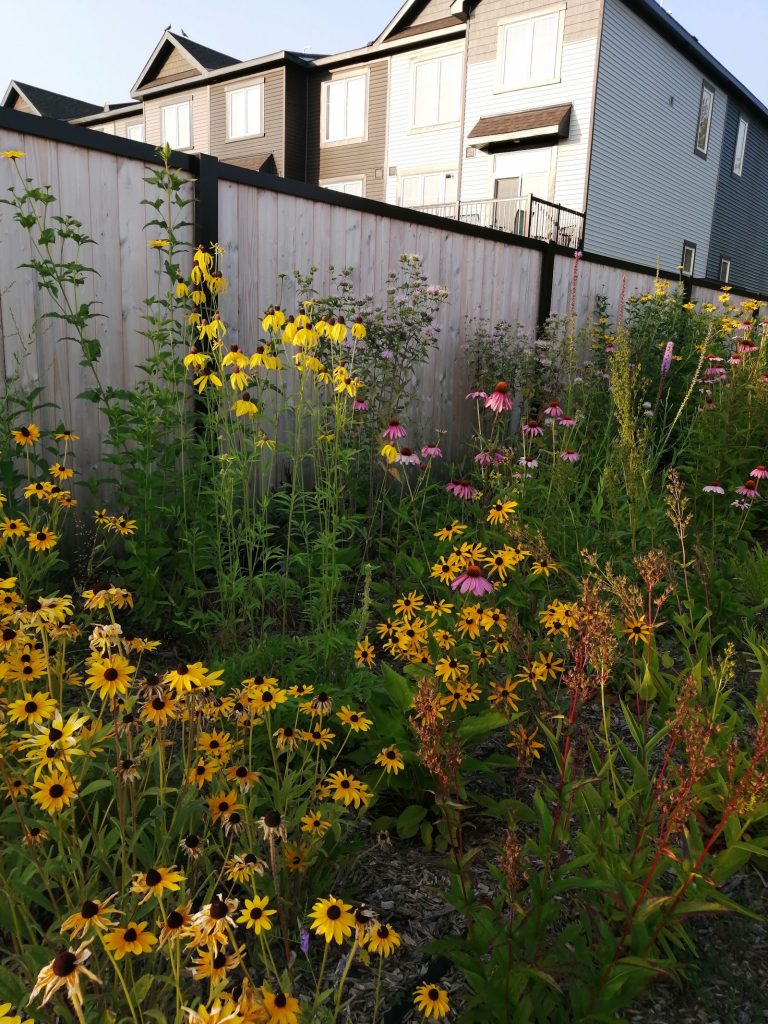 |
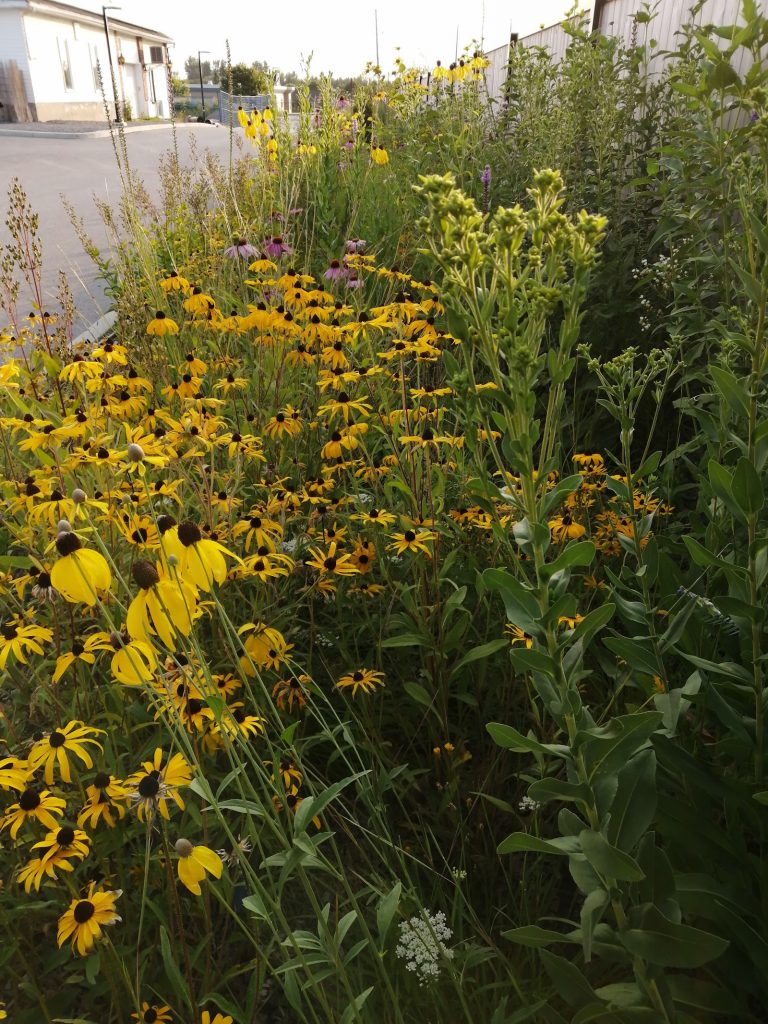 |
Kanata North Pollinator Patch
Hydro corridor at Abbeydale Circle Show on Map
 Kanata North Regeneration Stewards have just completed (in September 2023) a new large pollinator patch in the Morgan’s Grant area of the hydro corridor. At more than 100 m2, it is difficult to capture a single image of the garden. Click on image at right for larger view.
Kanata North Regeneration Stewards have just completed (in September 2023) a new large pollinator patch in the Morgan’s Grant area of the hydro corridor. At more than 100 m2, it is difficult to capture a single image of the garden. Click on image at right for larger view.
The Kanata North Pollinator Patch is currently heavily mulched to protect the seedlings from the heat wave and aggressive perennial weeds.
If you stop by the garden just south of Klondike at Abbeydale Circle anytime soon, you’ll see oats popping up in various places. They serve as a cover/nurse crop for the native wildflower seeds to be sown after the first hard frost.
See KN Regeneration Stewards for more about volunteering.
Contact: knregens@gmail.com
Lajoie/Jeanne-Mance city planters
Lajoie/Jeanne-Mance city planters Show on Map
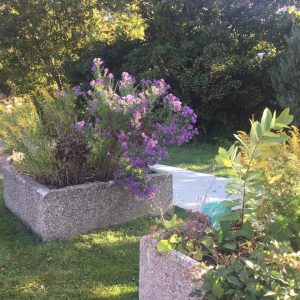 This set of 5 planters is maintained by Lynne Zeitouni and Firdaous. This photo, taken in September 2023, shows them bursting with native plants – goldenrods, asters, and milkweeds.
This set of 5 planters is maintained by Lynne Zeitouni and Firdaous. This photo, taken in September 2023, shows them bursting with native plants – goldenrods, asters, and milkweeds.
Landscapes of Canada Gardens
Just west of the Canadian Museum of Nature Show on Map
This outdoor space at the CMN features native trees, shrubs, and wildflowers found in Canada’s boreal forest, Arctic tundra, and prairie grasslands. Although not created for pollinators, the prairie garden, in particular, attracts a number of bees, butterflies, flies, and other insects.
Lansdowne ethno-botanic and demonstration gardens
East side of the Horticulture Building, Lansdowne Park Show on Map
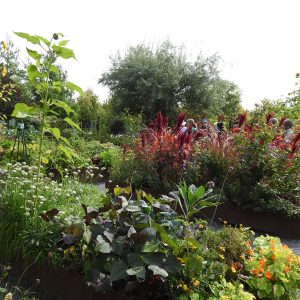 Raised garden beds next to the Horticulture Building at Lansdowne Park attract a variety of pollinators. They are intended to be educational demonstration beds designed to highlight food production, Ottawa’s horticultural heritage, and a sampling of other garden experiences that exist in Ottawa. The side benefit of growing both vegetables and flowers is that the garden attracts a large variety of pollinators and birds and demonstrates that a wide diversity of plants can be grown in raised beds.
Raised garden beds next to the Horticulture Building at Lansdowne Park attract a variety of pollinators. They are intended to be educational demonstration beds designed to highlight food production, Ottawa’s horticultural heritage, and a sampling of other garden experiences that exist in Ottawa. The side benefit of growing both vegetables and flowers is that the garden attracts a large variety of pollinators and birds and demonstrates that a wide diversity of plants can be grown in raised beds.
Lisgar school garden
Lisgar Collegiate Institute, Lisgar Street, Ottawa Show on Map
This garden includes both vegetable and pollinator beds, with a variety of species that are both native to Ontario and pollinator-friendly. It is maintained by student and staff volunteers.
Initially planned to produce local organic food for the school’s culinary program, the students soon realized they had to increase habitat for pollinators. Education is a big component of this project. Participants are learning as it evolves and reaching out to art, photography, biology, and health programs. The Lisgar Environmental Action Force (LEAF) is working toward making Lisgar a “bee school.”
Little library gardens
PrivateAgincourt Road, Bel Air Heights Show on Map
This front garden (below left), which is about 7 square metres, includes Boneset, Wild Bergamot, coreopsis, and echinacea, among other wildflowers.
Surrounding a Little Free Library, this 18-square-metre pollinator garden is just 2 years old. Most (90%) of the plants are native, 10% are old-root peonies that offer a wonderful dark green background for native blossoms.
Some of the plants for both were grown by the homeowner and Maitland Area Pollinator Project volunteers; others were purchased from Naturaide and Ferguson Forest Nursery.
Macoun Marsh Study Area
Southeast corner of Beechwood Cemetery, off St Laurent Blvd Show on Map

This corner of Beechwood Cemetery is often filled with children’s voices as well as the sounds of nature.
Located at the corner of Beechwood Cemetery, this natural area is maintained by volunteers, including many school children, under the leadership of science teacher Michael Léveillé. Many species of wild pollinators have been observed there.
Web site | Facebook page | Species found (iNaturalist)
MAPP – Agincourt Road boulevard garden
Agincourt Road, Bel Air Heights Show on Map
This boulevard garden – between the sidewalk and road – was designed and planted by Maitland Area Pollinator Project volunteers in 2024. Many of the plants were winter sown by the group. Others were purchased from Ferguson Forest Nursery, Gaia Nursery, Loblaws, and Home Depot. We were thrilled that they grew so well in their first year.
Just under 3 m wide, the garden is made up of two areas, 74 and 45 m2.
See MAPP blog post for more: Creating the Agincourt Road boulevard garden
Morgan’s Grant
Hydro corridor on both sides of Brady Avenue Show on Map

The meadow was seeded 5 years ago by Hydro One as part of a community project. It has matured into a sea of native flowers and grasses that feed pollinators and absorb storm water runoff.
Initiated by the Ottawa Stewardship Council (OSC), the Briarbrook and Morgan’s Grant Community Associations, Hydro One, and the City of Ottawa via former councillor Marianne Wilkinson are working to make this part of a hydro corridor into a haven for pollinators. According to an OSC representative, this is a win-win-win situation:
- The community gets a beautiful green space that is an asset to the neighbourhood, invites people to walk its paths, and provides an opportunity for learning about the environment and connecting with nature.
- Hydro One gets a corridor that won’t require costly maintenance to keep the land clear beneath the power lines.
- In place of a corridor filled with invasive species, Nature gets a meadow of native plants for pollinators that supports bees, butterflies, other insects, birds, and humans.
A great model for other communities!
For more about this project
- Morgan’s Grant greenspace revitalization on the OSC web site
- Morgan’s Grant hydro corridor on the BMGCA web site
- Summer report for 2020
See also: Hydro One’s list of allowable plants in rights-of-way
Photos from August 2022
MPCA – Arc Studio School pollinator garden
St Columba Anglican Church, Sandridge Road Show on Map
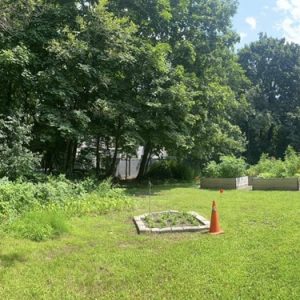 The Arc Studio School Pollinator Garden (about 4.5 square metres) was planted in the spring of 2024, by students of the school, using plants they winter-sowed with seeds from the Ottawa Wildflower Seed Library! It is adjacent to the Manor Park Community (vegetable) Garden at St Columba Church.
The Arc Studio School Pollinator Garden (about 4.5 square metres) was planted in the spring of 2024, by students of the school, using plants they winter-sowed with seeds from the Ottawa Wildflower Seed Library! It is adjacent to the Manor Park Community (vegetable) Garden at St Columba Church.
Another pollinator garden (about 5 square metres) is located at the side entrance to the church. It was installed in collaboration with Faith and the Common Good many years ago (and is listed under FCG on this page). In summer 2024, it was refreshed by Manor Park Community Association Environment Committee volunteers and is now part of the Manor Park Butterflyway Project. The volunteers are also working with the church and other youth groups (including the 63rd Ottawa Scouts and the Girl Guides group, which meet regularly on the grounds) to remove invasive species, including goutweed and buckthorn, from the church property.
MPCA – Aviation and Clarke
Aviation Parkway at Clarke Avenue Show on Map
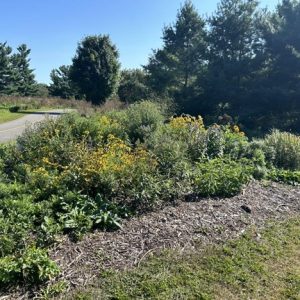 This garden, which is over 28 square metres, was developed as a collaboration between Manor Park’s Enviro Committee and Forêt Capitale with the support of the NCC. It is nestled between two Forêt Capitale reforestation sites along the Aviation Parkway on what was a large empty triangle of grass between the multi-use pathways.
This garden, which is over 28 square metres, was developed as a collaboration between Manor Park’s Enviro Committee and Forêt Capitale with the support of the NCC. It is nestled between two Forêt Capitale reforestation sites along the Aviation Parkway on what was a large empty triangle of grass between the multi-use pathways.
In addition to native perennials common in Ottawa, it features plants and grasses now rare in Ottawa including Little bluestem, Canada Wild Rye, Mountain Mint, White Vervain, Golden Alexander, and Figwort.
MPCA – Backyard butterfly garden
PrivateSt Laurent Blvd Show on Map
This 20-square-metre garden is in the shared backyard of an Ottawa Commmunity Housing Building. It was planted and is tended jointly by tenants and MPCA Enviro Committee volunteers and friends. Three planting areas in part sun are filled with thriving native perennials, surrounding raised vegetable beds in the centre of the space.
MPCA – Butterflyway garden at Bread & Roses Bakery
St Laurent Blvd Show on Map
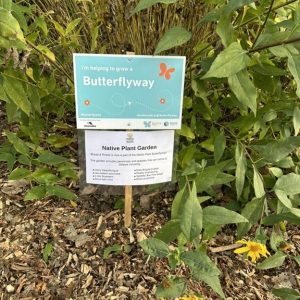 Local bakery, Bread & Roses, enthusiastically agreed to have the Manor Park Community Association’s Environmental Sustainability Committee volunteers add native plants to their gardens.
Local bakery, Bread & Roses, enthusiastically agreed to have the Manor Park Community Association’s Environmental Sustainability Committee volunteers add native plants to their gardens.
Along with existing rose bushes and the rare Eastern Prickly Pear Cactus, the small 7.5-square-metre gardens now feature New England Aster, Little Bluestem, Canada Columbine, Pearly Everlasting, and other drought-tolerant plants. All seedlings planted were grown from Ottawa Wildflower Seed Library seeds.
The bakery proudly displays a Butterflyway sign in the bed of Jerusalem Artichokes to the right of its front door.
MPCA – Manor Park native plant demonstration gardens
Manor ParkCommunity Centre Show on Map
This site, which is over 24 square metres, features three areas (shown in order below):
- a large sunny meadow on either side of the sidewalk at the entrance to the Manor Park Community Centre
- a raised planter featuring a variety of easy to grow, sun-loving native plants like Black-eyed Susan, Hairy Beardtongue and Wild Bergamot
- very drought-tolerant plantings in the concrete bed along the south wall of the community centre facing the splash pad
MPCA – Yule Manor pollinator garden
Claremont Drive Show on Map
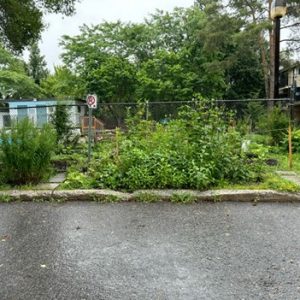 This 14-square-metre pollinator strip located between the parking lot of Yule Manor Co-Op homes and the Alvin Heights Wading Pool came about after a de-pave event organized as a collaboration among the EnviroCentre, Green Communities Canada, Yule Manor Co-Op residents, the Manor Park Community Council, and the Manor Park Community Association.
This 14-square-metre pollinator strip located between the parking lot of Yule Manor Co-Op homes and the Alvin Heights Wading Pool came about after a de-pave event organized as a collaboration among the EnviroCentre, Green Communities Canada, Yule Manor Co-Op residents, the Manor Park Community Council, and the Manor Park Community Association.
The area is part shade, and despite being a snow storage area in the winter, the salt-tolerant native plants keep coming back to brighten the space each growing season, and residents continue to maintain the garden.
MTN – École Marius Barbeau
École Marius-Barbeau, Notting Hill Avenue, Ottawa Show on Map
 As part of a Monarch Teachers’ Network (MTN) project to establish Monarch Waystations at schools across the city, this garden was started in 2012-13. It’s very small garden, under 200 square feet, but contains water features, a central path, small raised beds in the larger area, many, many colourful flowers, and lots of love.
As part of a Monarch Teachers’ Network (MTN) project to establish Monarch Waystations at schools across the city, this garden was started in 2012-13. It’s very small garden, under 200 square feet, but contains water features, a central path, small raised beds in the larger area, many, many colourful flowers, and lots of love.
In January 2019, we were pleased to hear from Katherine Hayashi, a teacher at this school: “I am very proud to say that my school garden at Marius-Barbeau is going strong. I found caterpillars for the first time last summer.”
Photo journal: École Marius-Barbeau
MTN – Hilson Outdoor Classroom
Hilson Avenue Public School, Hilson Avenue, Ottawa Show on Map
 As part of a Monarch Teachers’ Network project to establish Monarch Waystations at schools across the city, this garden was started in 2012-13.
As part of a Monarch Teachers’ Network project to establish Monarch Waystations at schools across the city, this garden was started in 2012-13.
Although this garden started modestly, at less than 200 square feet, it has grown as students and teachers use and appreciate it. In 2018, a teacher who was just learning about gardening and native plants contacted the Fletcher Wildlife Garden, which followed up with a site visit, advice, and the addition of more plants.
The garden is arranged in raised boxes that contain a number of Common Milkweed plants. In 2018, students added Butterfly Weed, Wild Bergamot, Beebalm, Columbine, Lance-leaved Coreopsis, and False Sunflower.
MTN – Mariposa Haven, Pakenham
Pakenham Public School, Pakenham, Ontario Show on Map
 As part of a Monarch Teachers’ Network (MTN) project to establish Monarch Waystations at schools across the city, this garden was started in 2012-13.
As part of a Monarch Teachers’ Network (MTN) project to establish Monarch Waystations at schools across the city, this garden was started in 2012-13.
The garden is a raised bed of about 300 square feet, next to the Pakenham Public School, where it has good drainage and gets a lot of light.
According to the management plan document, “The school has always had a very active gardening community. We are located in the country surrounded by farming families, and students that are very involved and interested in gardening. We currently have 2 gardens at the front of the school, a large garden on the side of the school, and some smaller gardens in the back where the students can rest and enjoy the plants and flowers. Our goal with this funding would be to enhance one of the gardens at the front of the school to its former glory, and use plants that would attract monarchs.”
Photo journal: Pakenham Public School butterfly garden
MTN – Neighbours and Nature Ensemble
Terry Fox Park, Orleans Show on Map
 As part of a Monarch Teachers’ Network (MTN) project to establish Monarch Waystations at schools across the city, this garden was started in 2012-13.
As part of a Monarch Teachers’ Network (MTN) project to establish Monarch Waystations at schools across the city, this garden was started in 2012-13.
Because it’s in a city park, many people were involved and “it was complicated.” The garden is planted in a circle, about 38 feet in diameter for a total of about 300 square feet. Residents, local schools, city staff, and of course teachers from the MTN were all involved in planning, planting, and maintenance. Local schools have been inspired by this garden to create their own garden or waystation.
Photo journal: Neighbours and Nature Ensemble: a community garden project
Blog post: Procedures and suggestions for establishing a waystation in a city park
MTN – Trillium’s Butterfly Hotel
Trillium Elementary School, Varennes Blvd, Orleans Show on Map
 As part of a Monarch Teachers’ Network (MTN) project to establish Monarch Waystations at schools across the city, this garden was started in 2012-13. It’s small – about 300 square feet in raised boxes – but was planted with 3 milkweed species plus annual nectar flowers like zinnia, and native perennials like Beebalm and Joe-Pye Weed.
As part of a Monarch Teachers’ Network (MTN) project to establish Monarch Waystations at schools across the city, this garden was started in 2012-13. It’s small – about 300 square feet in raised boxes – but was planted with 3 milkweed species plus annual nectar flowers like zinnia, and native perennials like Beebalm and Joe-Pye Weed.
Children in the child care and kindergarten groups helped build and decorate the boxes, plant, and water.
“Our goal for the garden is to not only create a butterfly waystation but to beautify our yard, get our parents and school involved, and have lots of fun doing it.”
The children made a photo journal to remember the beginnings of this garden: The making of Trillium’s Butterfly Hotel: a photo journal
Nandy Heule’s garden
PrivateCameron Ave, Old Ottawa South Show on Map
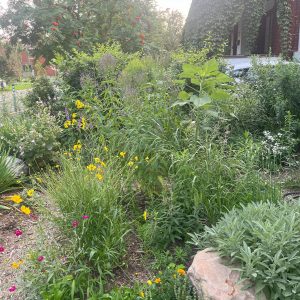 My front garden is almost 100% native (except for some spring bulbs, some Irises, and this year some non-native sunflowers). I’m moving into natives in the backyard as well. Right now bees are loving my hyssop.
My front garden is almost 100% native (except for some spring bulbs, some Irises, and this year some non-native sunflowers). I’m moving into natives in the backyard as well. Right now bees are loving my hyssop.
I’ve been a wildflower hobbyist for decades, trying to find the plants in their habitats. The switch to gardening with these plants was a small step for me. Volunteering at Fletcher Wildlife Garden helped as well (think of it as an ongoing feasibility study!). I set out to build a “habitat.” Sundaura at A Cultivated Art helped me decide to focus on a meadow-type environment.
I’m actually surprised how much I love the look of native plants in a garden. These plants truly belong here. I get a LOT of positive comments from neighbours.
Native plant demonstration garden
Princess Margaret Park, Kinnear Street, Ottawa Show on Map
Created and maintained by volunteers from the Civic Hospital neighbourhood
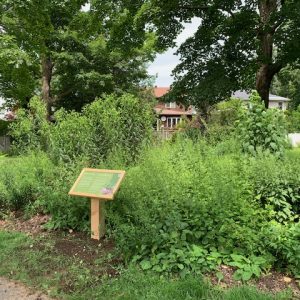 After the spring tulips fade, plants native to Eastern Ontario dominate the garden in the northeast part of Princess Margriet Park (formerly Fairmont Park). This garden was created to show off the beauty of easy-to-grow native plants. They’re also the kind of plants that attract birds and pollinators.
After the spring tulips fade, plants native to Eastern Ontario dominate the garden in the northeast part of Princess Margriet Park (formerly Fairmont Park). This garden was created to show off the beauty of easy-to-grow native plants. They’re also the kind of plants that attract birds and pollinators.
Native plants are those that occur naturally in a region. They are well adapted to the local climate and will provide a natural habitat for many species of animals and birds. Because of patches of native plants, like this one in Princess Margriet Park, you can expect to see more wildlife in the park. Be on the lookout for birds, insects, and maybe small mammals that will find food, protection, and nesting sites here.
Non-native species, on the other hand, can be invasive and may alter the ecosystem of an area. They are known to crowd out native plants. And local animals, unfamiliar with the foreign plants, don’t recognize these plants for food or shelter.
Native plant garden on Centennial
PrivateCentennial Boulevard Show on Map
I started converting my garden in 2015. I now have around 100 native species (mainly perennials, some grasses and ferns), mainly sourced from the Fletcher Wildllife Garden and Beaux Arbres, and a number of near natives. I have quite a big shade section, a middling number of partial shade plants, and a hard-fought-for sunny section, which will eventually have to be converted as the red oak gets bigger.
The garden is a constant source of entertainment, from when the bloodroot, wild ginger, jack in the pulpit, and dutchmans breeches first break through in spring to the last visits of the hummingbirds to the cardinal flowers and ironweed in early fall.
This season was the first time I’ve had snowberry clearwing moths, but I always get a flurry of different butterflies visiting to lay eggs, lots of different bees, nesting birds, damselflies, and dragonflies. I’ve had visits from merlins, coopers hawks, sharp-shinned hawks, and had a few years of leopard frogs living in the flower borders.
Nault Park pollinator garden
Nault Park Show on Map
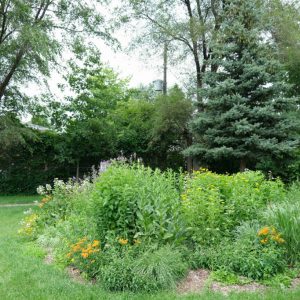 Nault Park in north Vanier has a playground, a water splash pad, a pavilion, and a large open green space. Two separate, teardrop-shaped pollinators gardens are set near the pathway, which runs through the park on the north side, connecting pedestrians and cyclists from Ste. Anne Street to Boudreau Street. The large sun garden is approximately 300 square feet and the small shade garden is 40 square feet.
Nault Park in north Vanier has a playground, a water splash pad, a pavilion, and a large open green space. Two separate, teardrop-shaped pollinators gardens are set near the pathway, which runs through the park on the north side, connecting pedestrians and cyclists from Ste. Anne Street to Boudreau Street. The large sun garden is approximately 300 square feet and the small shade garden is 40 square feet.
The Nault Park Pollinator Garden is an initiative of the Vanier Community Association and their Beautification Committee. The project was initially sparked by the Committee’s participation in the Suzuki Foundation’s Butterflyway program and the desire to increase local biodiversity and build pollinator habitat.
Old Ottawa South – library gardens
Ottawa Public Lirary, Sunnyside Branch, 1049 Banks Street Show on Map
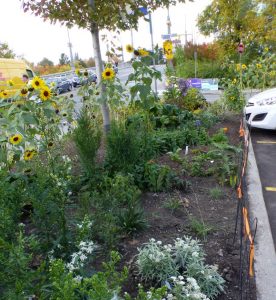 Started many years ago by the library’s custodian, this garden is maintained by Green Dreamers, who also take care of a number of street beds on Bank Street in Old Ottawa South.
Started many years ago by the library’s custodian, this garden is maintained by Green Dreamers, who also take care of a number of street beds on Bank Street in Old Ottawa South.
In 2018, the GDs planted a number of native wildflowers including Pearly Everlasting (front of photo), New England Asters, Joe-Pye Weed, bergamot, and others, in the large garden bed between the sidewalk and parking lot next to Sunnyside branch of the Ottawa Public Library.
In 2024, GDs added Culver’s Root, Barren Strawberry, Grass-leaved Goldenrod, Canada Columbine, and other species around a serviceberry tree in a large square bed next to the library.
Contact: envirocrewoos@gmail.com
Old Ottawa South – street and rain gardens
Bank Street from canal to river and Sunnyside Avenue from Roslyn to Fairbairn Show on Map
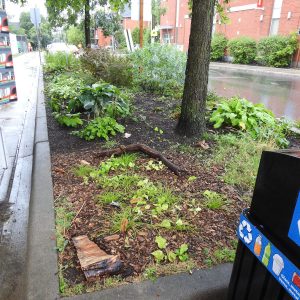
The garden next to Wall Space Gallery contains Downy Yellow Violets, sedges, Culver’s Root, Wild Strawberries, Mountain Mint, and Thimbleweed. The shrubs in the middle are Ninebark.
The gardens along Bank Street in Old Ottawa South started as a traffic-calming measure. The three rain gardens on Sunnyside were a pilot project installed and monitored by the city. Almost 10 years later, they are all maintained by Green Dreamers, a volunteer group of local residents who love making their neighbourhood look beautiful.
The GDs have an Adopt-a-Road agreement with the city’s Public Works and Environmental Services Department for the street gardens and a maintenance agreement with its Stormwater Management group for the rain gardens.
They also take care of the gardens at the Sunnyside branch of the public library and at the community centre. They have no formal agreements for those, but maintain close communication with the managers of the facilities and obey the general rules for roadside planting.
For more, see Street and rain gardens in Old Ottawa South
Contact: envirocrewoos@gmail.com
Pinhey Sand Dunes
Slack Road, east of Woodroffe Show on Map
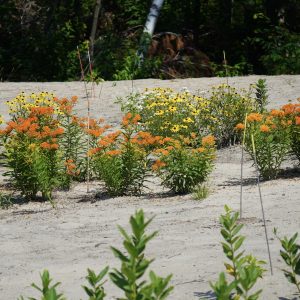 Biodiversity Conservancy International (BCI) is an Ottawa-based non-profit, which is doing habitat restoration in the Greenbelt. Historically, Pinhey Sand Dunes was a vast open sand dune and meadow habitat until it was planted with pine trees in the 1950s. BCI is bringing back the open dune habitat to protect the rare species that rely on this environments.
Biodiversity Conservancy International (BCI) is an Ottawa-based non-profit, which is doing habitat restoration in the Greenbelt. Historically, Pinhey Sand Dunes was a vast open sand dune and meadow habitat until it was planted with pine trees in the 1950s. BCI is bringing back the open dune habitat to protect the rare species that rely on this environments.
Their focus is on reintroducing pollinator-friendly native species and butterfly host plants interspersed in the sand. Their current plan is to create suitable habitat for the reintroduction of the Mottled Duskywing butterfly to Eastern Ontario in the next few years. The open area is currently about 400 square metres.
See the blog post about the WPP tour of the dunes: Visiting Pinhey Sand Dunes
Contact: Griffin Wright-Brown
Biodiversity Conservancy International
Rideau Environmental Action League (REAL)
William Street, Smith's Falls, Ontario Show on Map
 REAL is developing a demonstration Monarch Garden on the REAL Deal site as a 30th anniversary project. Significant benefits will include:
REAL is developing a demonstration Monarch Garden on the REAL Deal site as a 30th anniversary project. Significant benefits will include:
- Critical habitat for the at-risk monarch butterflies: milkweed host plants for breeding stage, other colourful native nectar plants for feeding
- Habitat for other pollinators: other butterfly species, birds, bees, and insects.
- Visually attraction to human residents and tourists
- Demonstration of what others can do on their own properties to enhance the local monarch population
- An ongoing support to monarch populations in coming years
- Legacy project for REAL’s 30th anniversary
Website: Monarch Garden
August 2020: ‘Extinction is a process:’ REAL plants second butterfly garden to help declining pollinator populations
Contact: Barb Hicks
Rideau Hub
Rideau Community Hub, Saint Laurent Boulevard Show on Map
 In 2022, the Ottawa Wildflower Seed Library (OWSL) entered into an agreement with the Rideau-Rockcliffe Community Resource Centre (RRCRC) to plant a pollinator strip along the side of the old Rideau High School building. The RRCRC is a community hub and has good OC Transpo access. The centre’s services are for residents of Rideau-Rockcliffe ward, but as with all community centres, the building and grounds are open to the public.
In 2022, the Ottawa Wildflower Seed Library (OWSL) entered into an agreement with the Rideau-Rockcliffe Community Resource Centre (RRCRC) to plant a pollinator strip along the side of the old Rideau High School building. The RRCRC is a community hub and has good OC Transpo access. The centre’s services are for residents of Rideau-Rockcliffe ward, but as with all community centres, the building and grounds are open to the public.
Social Harvest prepared two long garden strips along the former school walls and the Fletcher Wildlife Garden donated plants to fill them.
See blog post: OWSL demonstration beds
Riverview Park Pollinator Garden
Hospital Link Rd, near Riverview Park Show on Map
 In October 2022, the Friends of Riverview Park Green Spaces and a group of volunteers planted over 370 pollinator seedlings of 25+ species of sun-loving, mostly native, perennial flowers and grasses in a 6 by 12-m oval garden. The project was funded as part of a 2021 federal Healthy Communities grant. The garden is located on City of Ottawa land that our community association stewards near the Children’s Hospital of Eastern Ontario and the Ottawa Hospital – General campus. Seeds came from the Ottawa Wildflower Seed Library, the Fletcher Wildlife Garden, and some local volunteers and were mostly started under lights.
In October 2022, the Friends of Riverview Park Green Spaces and a group of volunteers planted over 370 pollinator seedlings of 25+ species of sun-loving, mostly native, perennial flowers and grasses in a 6 by 12-m oval garden. The project was funded as part of a 2021 federal Healthy Communities grant. The garden is located on City of Ottawa land that our community association stewards near the Children’s Hospital of Eastern Ontario and the Ottawa Hospital – General campus. Seeds came from the Ottawa Wildflower Seed Library, the Fletcher Wildlife Garden, and some local volunteers and were mostly started under lights.
We were amazed at how well the plants came through their first winter and how full the garden was even in its first year. Lots of pollinators visited flowers from June through October, and birds visited seed heads in the fall. You can find the garden just off the Hospital Link Rd (follow the path from the crosswalk 300 m east of Alta Vista Drive) or park in Riverview Park and follow the path from the end of Knox Cr. near Cluny Street.
See blog post: Riverview Park Pollinator Garden
Sandy’s front garden
PrivateAylmer Avenue, Old Ottawa South Show on Map
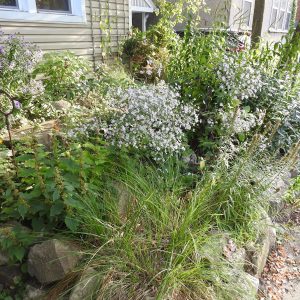 This garden is very tiny (about 25 square m plus another 12 around the side of the house), close to the street, and in an urban neighbourhood, but it does attract pollinators, including ground-nesting bees. It has evolved considerably over the years as the chokecherry tree grew and cast more shade and as I learned more about native wildflowers and pulled out periwinkle.
This garden is very tiny (about 25 square m plus another 12 around the side of the house), close to the street, and in an urban neighbourhood, but it does attract pollinators, including ground-nesting bees. It has evolved considerably over the years as the chokecherry tree grew and cast more shade and as I learned more about native wildflowers and pulled out periwinkle.
Left over from sunnier times are Culver’s Root, Obediant Plant, and Blazing Star. New with shadier conditions are Heart-leaved Aster, Zigzag Goldenrod, Giant Yellow Hyssop, New England Aster (which seems to thrive in any light conditions). Photo from September 2024.
That’s Foxtail Sedge in front, but it’s so large, I plan to replace it with a smaller sedge, possibly Plantain Sedge.
A Wild Raisin shrub blooms in spring, then gets buried under the asters. Wood Poppy and violets are also early bloomers.
Selby Plains/Atlantis Pollinator Garden
Selby Avenue at Atlantis, Sir John A. MacDonald Parkway Show on Map
 Dave Adams, who takes care of the winter trail along the Sir John A. MacDonald Parkway, started a pollinator garden this summer (2020). Removing invasive buckthorn trees was difficult, but the hardy native species and other wildflowers he is planting are flourishing.
Dave Adams, who takes care of the winter trail along the Sir John A. MacDonald Parkway, started a pollinator garden this summer (2020). Removing invasive buckthorn trees was difficult, but the hardy native species and other wildflowers he is planting are flourishing.
This project is sponsored by the Westboro Beach Community Association in consultation with the National Capital Commission.
See blog post: Selby Plains/Atlantis Pollinator Garden: end of season report
SNMC pollinator garden
Woodroffe Avenue, Ottawa Show on Map
At the South Nepean Muslim Centre (SNMC), we have converted parts of the landscaping that previously had grass (weeds) into pollinator friendly garden spaces with both Ontario native and non-invasive exotic plants to support pollinators and other wildlife in our attempts to support ecological biodiversity.
In September 2021, with the help of community volunteers, we established the first garden along the 180 ft long bed along the main entrance off Woodroffe Ave. In summer of 2022, we added another patch of wasted space at the back of the property into a garden bed. Our most recent addition to the garden in the fall of 2023 was the conversion of a large parking lot median into a thriving garden of perennials and grasses.
These gardens survive on rainfall and are hardly ever hand watered (except for when new plants are installed).
Sugar Bush Road pollinator plant pilot project
Sugar Bush Road, Pakenham Show on Map
 In May 2019, Scott Sigurdson and his neighbours on Sugar Bush Road near Pakenham, Ontario, set out to restore pollinator habit along 2 km of this country road. They seeded with a legume mix – clover, alfalfa, and vetch. Then added a variety of wildflower seeds later in early summer.
In May 2019, Scott Sigurdson and his neighbours on Sugar Bush Road near Pakenham, Ontario, set out to restore pollinator habit along 2 km of this country road. They seeded with a legume mix – clover, alfalfa, and vetch. Then added a variety of wildflower seeds later in early summer.
Wild Parsnip is a problem in this area, and the volunteers are pulling it out by hand, as they want to keep the road free of herbicides.
For more information and photos, see the project’s Facebook page.
See our blog post about the project: Roadside pollinator habitat – Sugar Bush Road
Tapestry Garden
PrivateAvondale Avenue, Ottawa Show on Map
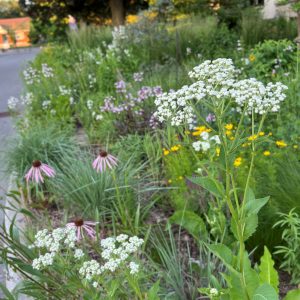 This boulevard garden, which covers 130 square metres, is located next to roads on a busy corner that was torn up for infrastructure upgrades 6 years ago. The soil is sandy loam (low water-holding capacity, low nutrient-holding capacity) with added backfill of sand and gravel mix.
This boulevard garden, which covers 130 square metres, is located next to roads on a busy corner that was torn up for infrastructure upgrades 6 years ago. The soil is sandy loam (low water-holding capacity, low nutrient-holding capacity) with added backfill of sand and gravel mix.
Inspired by Doug Tallamy’s Nature’s Best Hope, Christine took this opportunity to make a garden that would support more creatures. A garden designer, but new to native species at the time, she dived in. The garden was planted over two summers in 2020 and 2021.
Disturbance – from people and dog traffic and snow removal practices – is constant, so the plant community has to be resilient. Christine used a mixture of interplanted grasses and forbs, many chosen from Ontario native dry meadow and dry shade plants. The planting is not exclusively native; some plants are included because of their visual interest in seasonal vignettes. Christine says she’s learning how to keep a balance of grass and forbs, as well as adjudicating the heavy self-seeders who would outcompete others if not edited by the gardener’s hand.
See blog post: Christine Edmond’s boulevard garden
Trillium Park pollinator garden
Eleanor Drive at Trillium Avenue, Nepean Show on Map
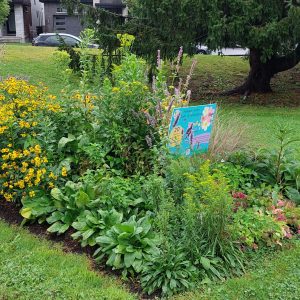 This 19 square metre garden is an initiative of the Fisher Heights and Area Community Association (FHACA) in partnership with the Nepean Horticultural Society (NHS). FHACA was successful in obtaining a grant from the City of Ottawa to fund the creation of a garden. In deciding where to establish the garden, FHACA negotiated with City staff with the help of the local councillor to obtain permission for a site in Trillium Park. The rationale for choosing the Trillium site was that it is in an area with high visibility with considerable vehicle and pedestrian traffic.
This 19 square metre garden is an initiative of the Fisher Heights and Area Community Association (FHACA) in partnership with the Nepean Horticultural Society (NHS). FHACA was successful in obtaining a grant from the City of Ottawa to fund the creation of a garden. In deciding where to establish the garden, FHACA negotiated with City staff with the help of the local councillor to obtain permission for a site in Trillium Park. The rationale for choosing the Trillium site was that it is in an area with high visibility with considerable vehicle and pedestrian traffic.
In spring 2024, volunteers from the community removed sod, added compost-rich soil and mulch, and planted 20 varieties of native pollinator plants. The planting was based on a plan provided by a member of the NHS. The garden benefitted from an ideal spring and summer that saw sufficient precipitation for the garden to flourish in its first year. The mulch did its job and reduced the need for weeding. Nonetheless, volunteers still watered and weeded throughout the growing season as needed.
Trinity Youth Wildlife Garden
Richardson Side Road, Carp, Ontario Show on Map
 Established in 2015, the Trinity Presbyterian pollinator garden in Kanata is home to native plants that provide nectar and pollen to beneficial insects and birds. The church’s youth group was inspired to start the garden and led the design and implementation with the support of the congregation. The youth group and the congregation maintain this pollinator garden.
Established in 2015, the Trinity Presbyterian pollinator garden in Kanata is home to native plants that provide nectar and pollen to beneficial insects and birds. The church’s youth group was inspired to start the garden and led the design and implementation with the support of the congregation. The youth group and the congregation maintain this pollinator garden.
University of Ottawa
Main campus between Waller, Laurier, King Edward, and Marie-Curie Show on Map
 The university’s many gardens include pollinator patches:
The university’s many gardens include pollinator patches:
- Learning Garden (UCU, Leblanc sites)
- Community Garden (King Edward site)

